Posts posted by RomiK
-
-
-
1 hour ago, Architeuthis said: Thank you for these industrious testings, RomiK... 👍
From your test photos under controlled environment, I conclude that the 8-15mm/2xTC/140mm combo is at least as good as 28-60mm/WACP-C, maybe even a tick better (you agree?). The differences are subtile, I am glad to see that the 8-15/2xTC combo can keep up with modern wetlens solutions...
I derived to similar conclusions based on my own photos, but these were just UW photos of different subjects at different times and conditions, by far no control...
Yes I agree very much. Optically it seems there is no bad apple and the differences are subtle (apart from characteristics given by their nature (diopter vs dome). There is always some CA, some unsharpness but the central part of the image seems to be on par. Where did WACP-C really surprised (compared to WWL1) me was the long end which I considered with WWL1 very soft and I attributed it to the lens. So when I saw what I saw with WACP my jaw dropped. I will have to reshoot WWL with flash as it seems to me that we have to feed these optics (also EMWL) with a lot of light to produce good results.
1 hour ago, Architeuthis said: #1.: Concerning your listing of costs and the Canon 8-15mm combo, I think it is fair to add that the N100/N120 adapter, 140mm dome, both N120 extensions and Sony 2x TC are universal and can be used for various other occasions, both UW and OW as well (even the Canon 8-15mm with Metabones is fun to use over the water)...
With the WACP-C combo, one is left with a bold chunk of optical glass that is dedicated to its purpose plus one universal N100 30mm extension and a mediocre 28-60mm lens (o.k. the charm of the 28-60mm lens for OW use is its size, but I personally prefer the Sony 20-70mm that is bigger, but still not excessive, and provides clearly better IQ, both OW and UW)
=> I would say one gets a lot more with the Canon 8-15mm combo (also the 180° diagonal FOV, what the WACP-C cannot deliver) for a simlar amount of money...
To me WACP even though dedicated it still is a tool and the main benefit would be the use of native AF and its performance. To me the use of native AF trumps all the other cards. Even without video in mind I am experiencing quite a few misses on 8-15 shots including the lab pictures from pool.
1 hour ago, Architeuthis said: #2.: I am surprised to see that the Canon 8-15mm performs optically better behind the rectilinear 180mm domeport, compared to WACP-C, maybe even a tick better compared to 8-15mm behind hemispherical 140mm domeport. This is completely unexpected for me, but in line with my observations when I used the Canon 8-15mm behind 140mm and rectilinear 170mm domeports with MFT cameras, where the smaller sensor scans only the central 25% area within the image circle. IQ with 170mm domeport there was at least as good compared to the 140mm, if not better (just comparison of regular UW photos, no controlled environment)...
So much for universally adopted truth right?! :-) I was surprised too! => never trust these internet wisdoms until you see it for yourself :-). I'd say the CA was more pronounced towards the edges as expected but the horizontal lines stayed sharp until the end!
1 hour ago, Architeuthis said: Wolfgang
P.S.:At present, my WACP-C stays a lot at home, when I go for scuba travel (I am a big fan of 180° diagonal and miss it with the WACP-C; I also find the 8-15(2xTC/140mm rig more manageable OV and UW). Not enough time has passed, but maybe I will put my WACP-C in classified to help finance an EMWL some day...😊
Oh god, I could have saved some money perhaps... or we could have swapped my EMWL (just kidding :-) ... I will see how I like WACP-C in Lembeh - Halmahera and also how I like and how it will work my new way of packing presenting housing+WACP+camera-handles-ballmounts as a personal item in addition to my carry-on :-)
7 hours ago, John E said: Thanks for the tests.
It is good to also see the price and weight comparison. If someone is starting from scratch very comparable, if someone already has components, or other uses for the lens, it looks like these can be bigger factors versus image quality in making a choice.
I do note the 1.4x Kenko and Sigma MC11 converter combination is quite a lot cheaper than the Sony 2.0x (or 1.4x) and Metabones V. I am not sure of availability of the zoom gear for 2x teleconverters but it seems most housing manufacturers make one for the 1,4x and 8-15mm.
one note is that MC11 doesn't support video and AF-C either
7 hours ago, John E said: I use an Isotta housing with an 8 inch polycarbonate dome (about 500g lighter than the Nauticam 140mm and needing less floatation). I can use the same extension and dome for both the Sony 20-70mm and the 8-15mm with 1.4. It means I can swap the lenses out on a multi-dive day small boat without changing anything about the housing, extensions or port. For example in Palau, changing from the 20-70 for sharks, turtles, fish portraits and people photos, to fisheye for the big wall, reef scenes and schooling fish pictures. Very handy and a good travel combination. If the dome gets scratched there is a good chance I can polish it so not as nerve wracking when other people handle the housing.
I too love 20-70. For me it's the ultimate lens for where you expect unexpected :-) it's sharp like hell and cropping into 50Mpix at 70mm is like macro. It is less ideal for wrecks caves and big ocean but other that its amazing lens! The attached images of 3 nudis as well as stitched (!!) panorama were taken by it at Cape Verde couple months back.
3 hours ago, Chris Ross said: In fact I'm wondering if Nauticam could have perhaps worked with someone like Metabones to develop a custom 2x converter tuned to the 8-15 lens rather than developing the FCP port. It might avoid the limited depth of field the FCP seems to have at close focus. You could have a 1.5x model as well which could be used on APS-C and would also find application on full frame. All of this is possible due to the high optical quality of the Canon 8-15.
My short experience with 8-15 and DOF is quite opposite - in reality I have to be very very close to the subject for it to have meaningful impact in the frame while shooting at wide angle. Which means that the lens is focusing at its or close to minimum focus distance which means that no matter aperture you throw at it the DOF will be quite shallow (as the hyperfocal distance is like 3m for this lens?). Because behind the dome the focus distance is like 1/3 right? So the subject 1m away - which is like a mile when at 15mm - will focus at 30cm. And subject right at your dome will focus at 15cm. With all implications for DOF.
While nauticams diopters will move the focus point like 3x away so the subject 0.5m away will focus at 1.5m which in turn will produce much greater DOF even with mediocre 28-60 sufficiently closed down. I think I demonstrated this in my other post about 8-15 and WWL1.
Unless I am missing something these diopters will in reality produce greater FOV - not smaller - than fisheye behind the dome 🤷
-
-
Before leaving for Indonesia tomorrow I was able to do a quick comparison between my new addition WACP-C and adapted 8-15 the photos of which I made back in spring. Disclaimer is that WACP samples were done with the strobe at ISO100 while for 8-15 I was using video light at higher ISO and so the results might not 100% comparable. Will reshoot when I have time.
First the costs and weights of both systems (8-15 quoted at used price level):
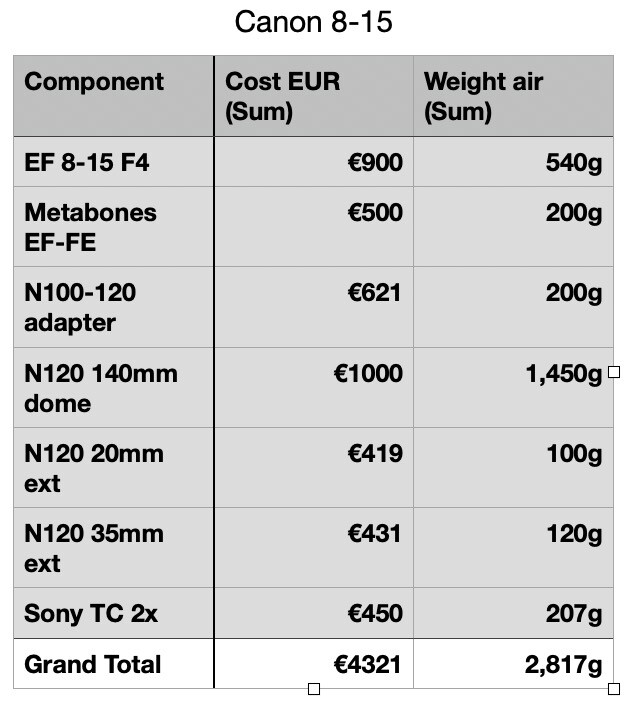
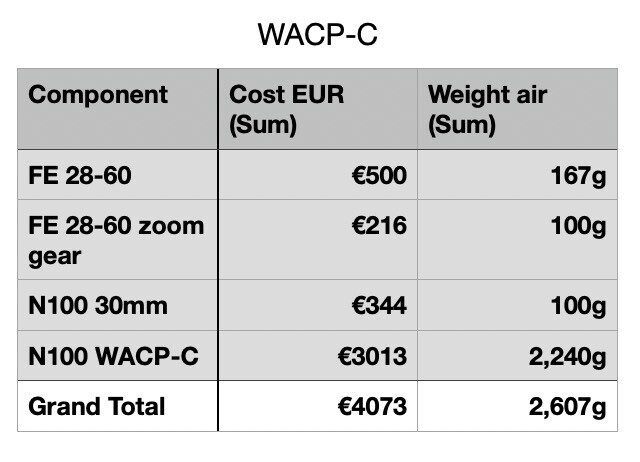
Both systems are kind of neutral-ish buoyant in this configuration:
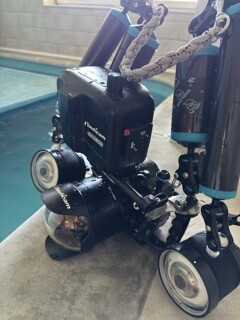
The following screenshots have this system: first Fit view followed by 300% comp view with rectangle at left upper corner showing the part of the frame compared.
As I stated earlier I picked up samples which showed good focus for 8-15 as weaker light and also shutter speed without flash sometimes produced unfocused images. But these I think were sharp in the center and so let's get on with these.
8-15 TC2x in 140mm dome 55mm+35.5mm N100/120 vs WACP-C both F11:
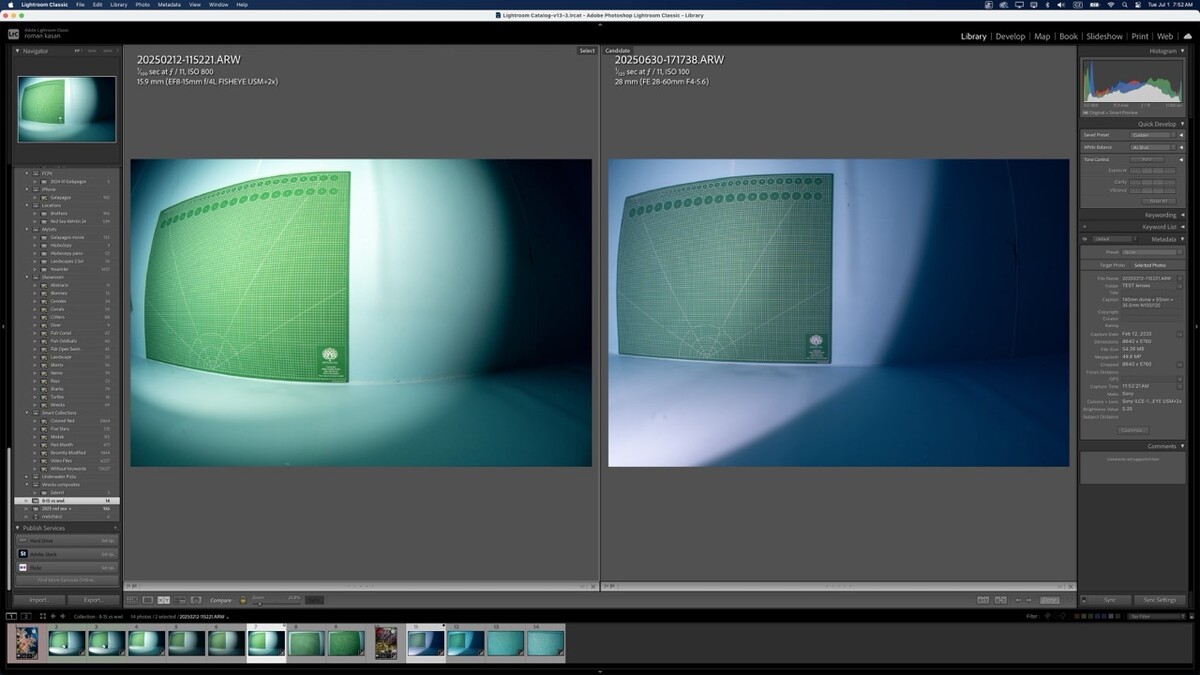
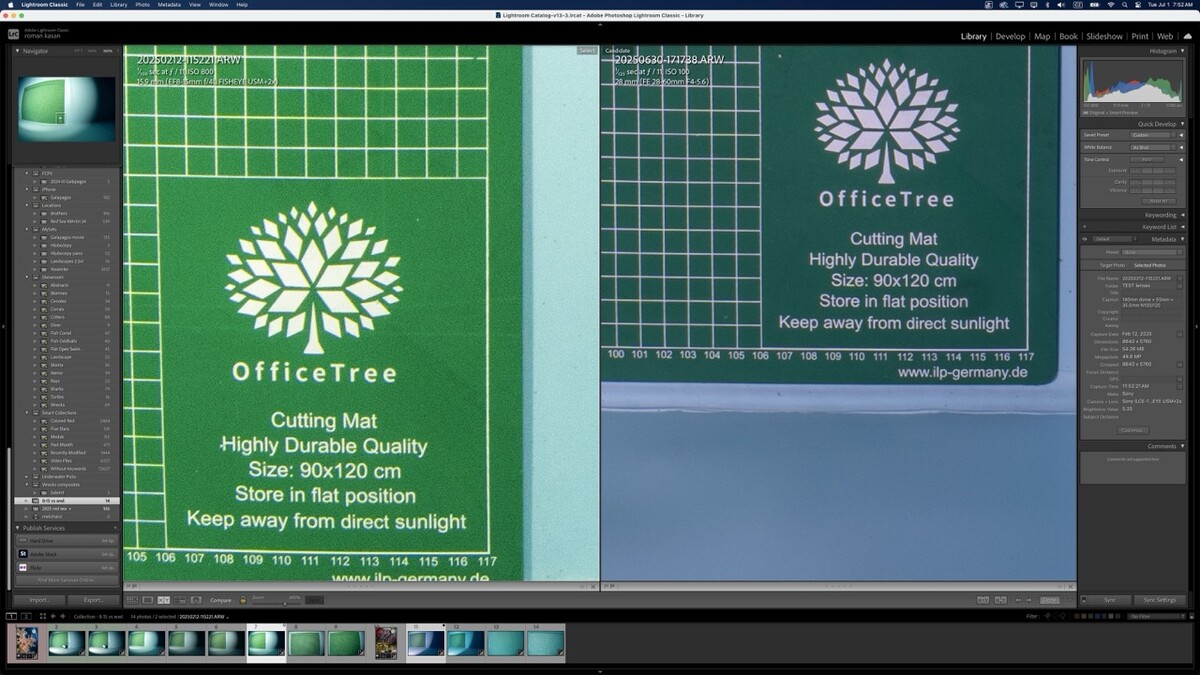
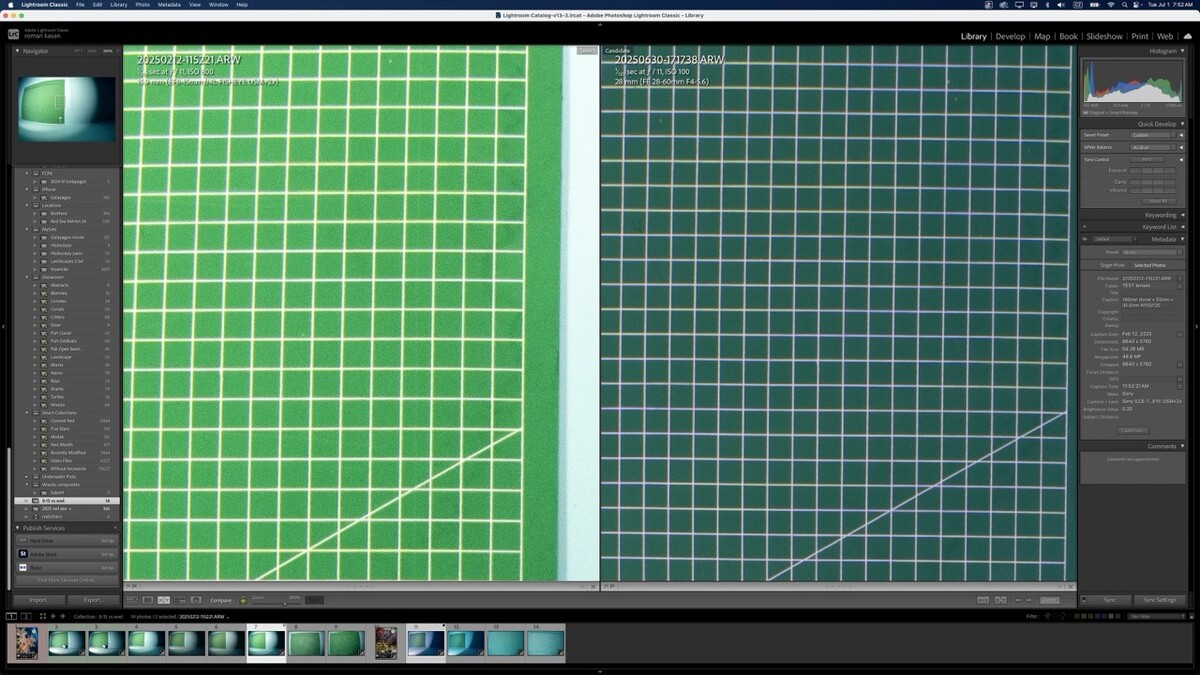
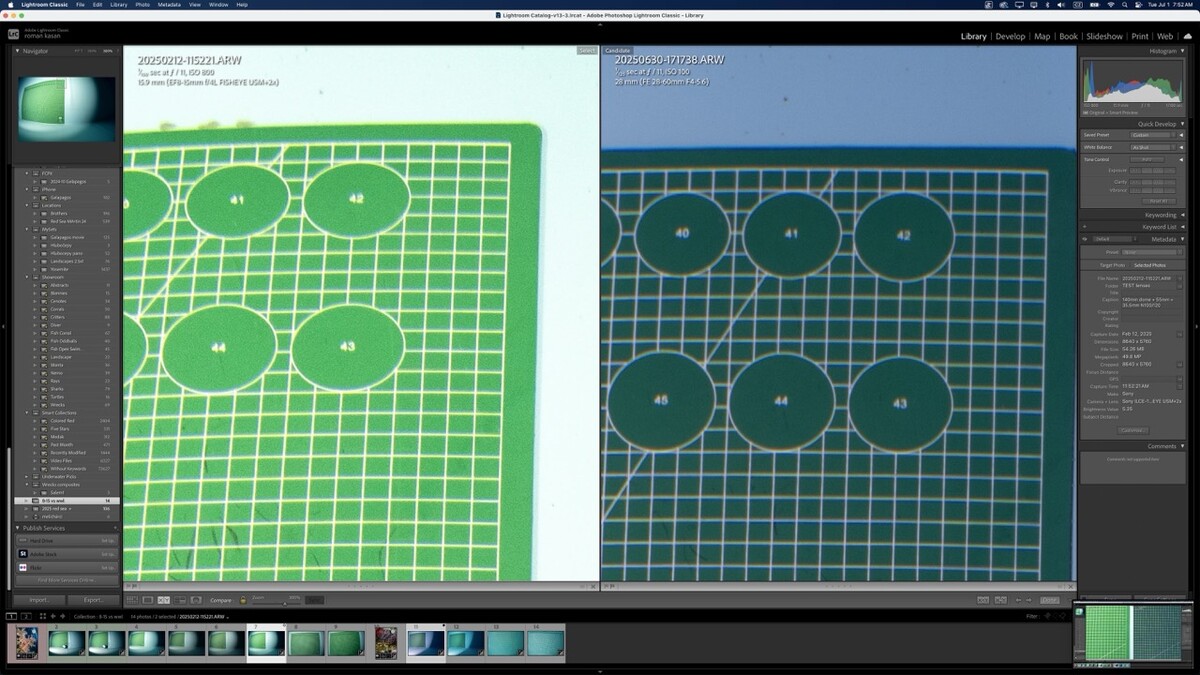
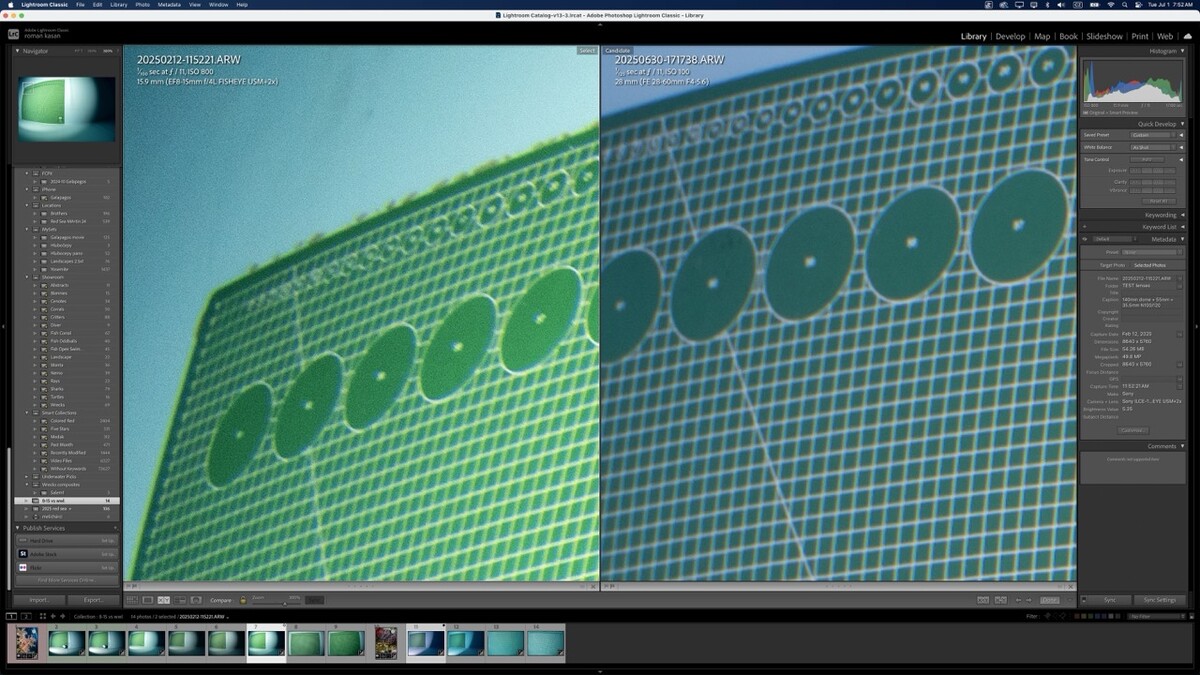
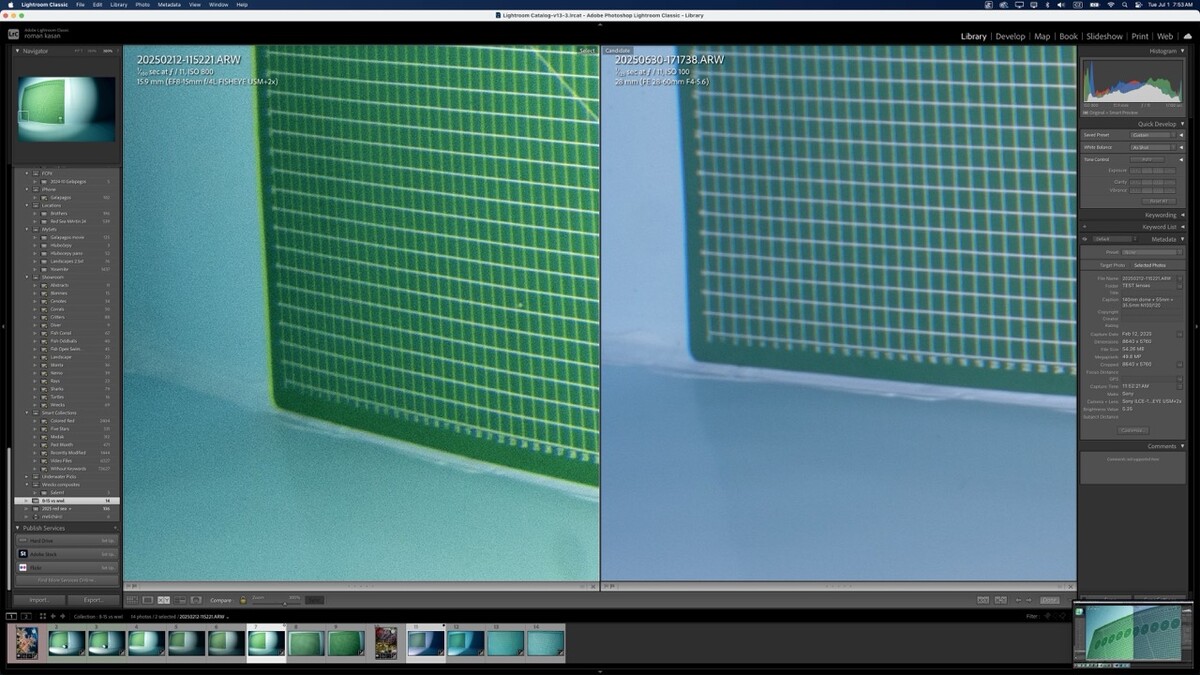
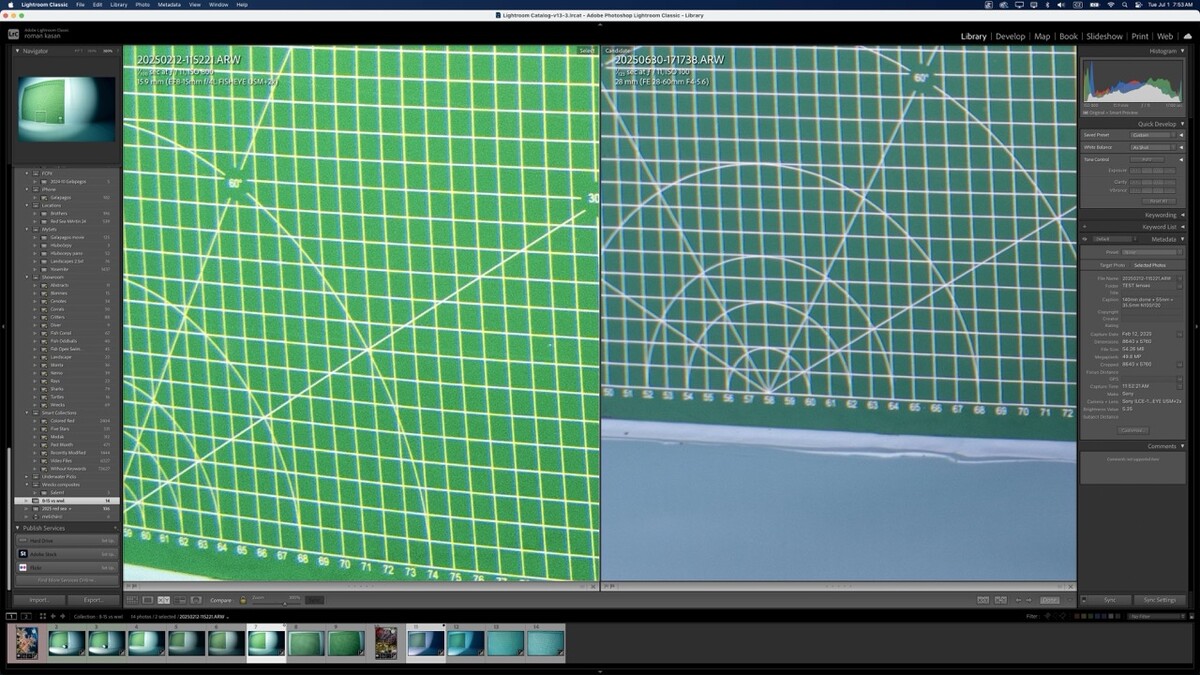
... and 8-15 TC2x 55+35.5 in 180mm dome vs. WACP-C 28mm:
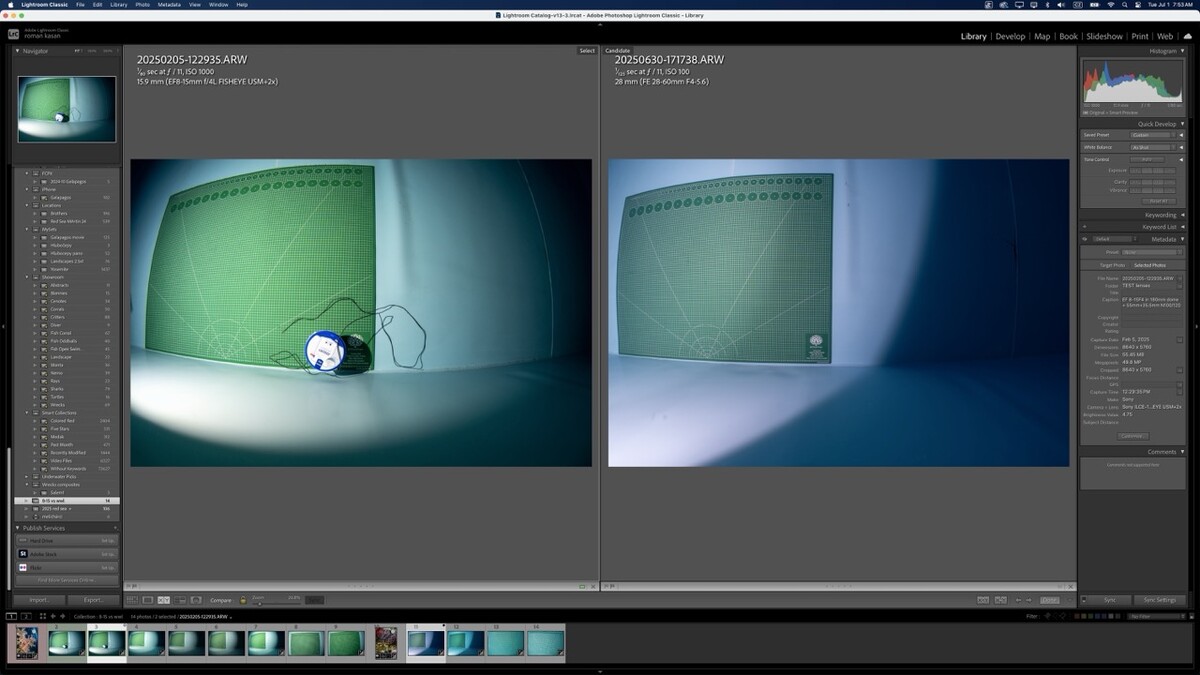
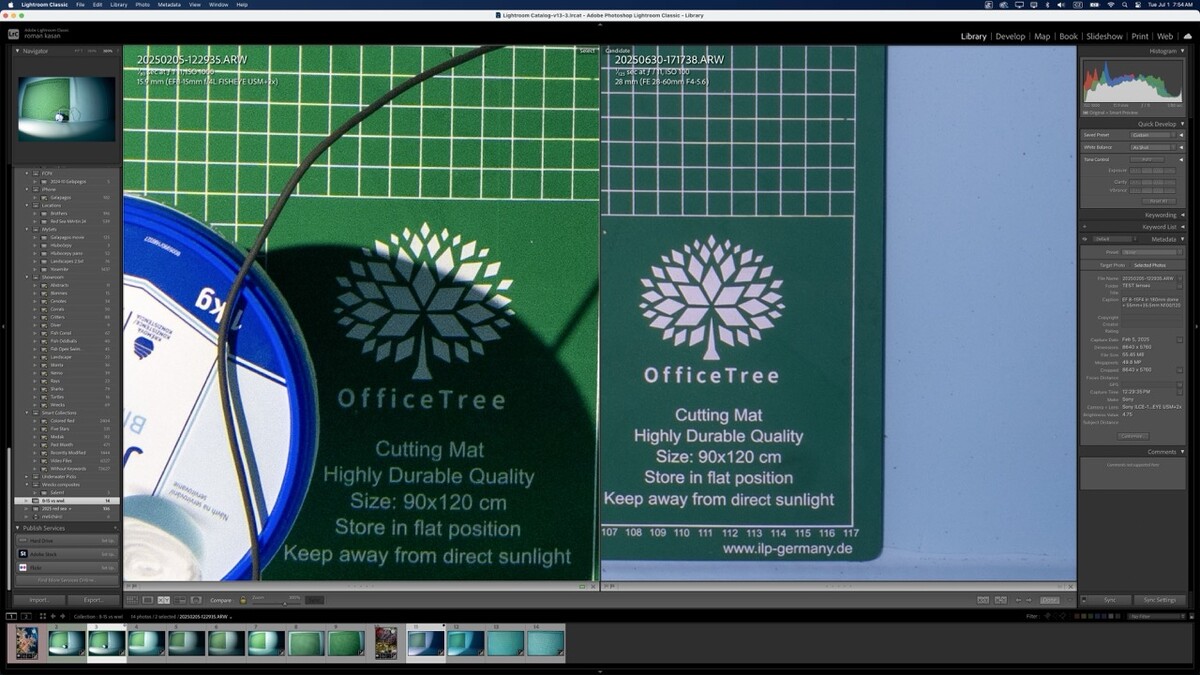
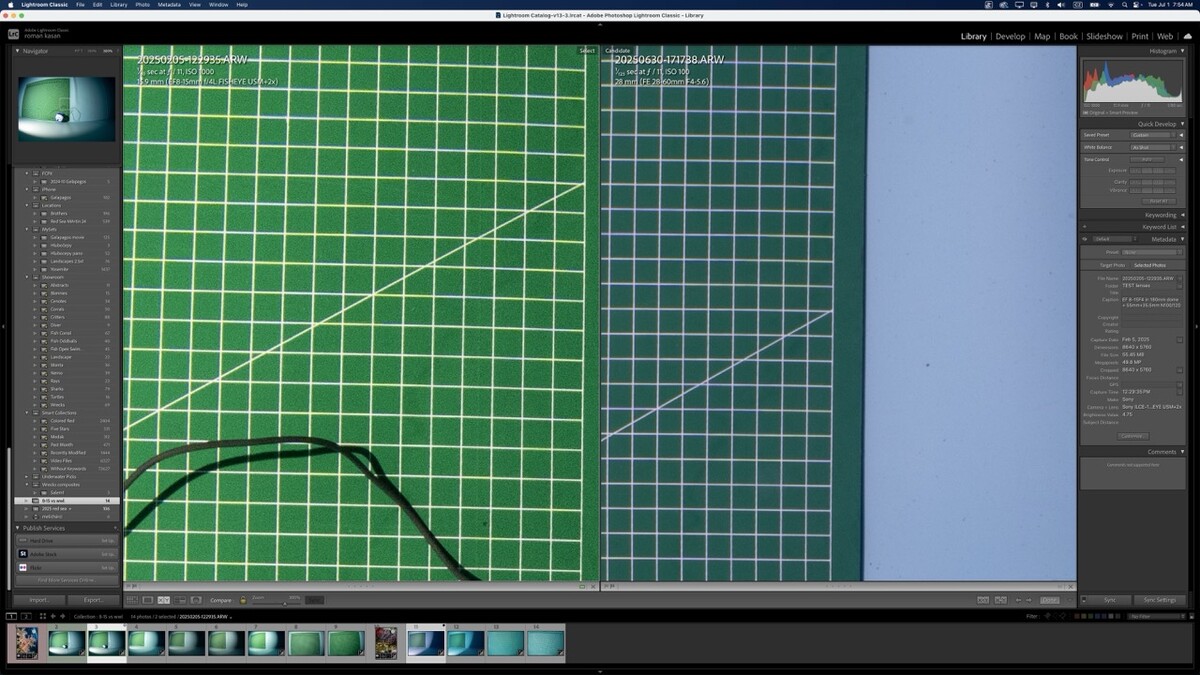
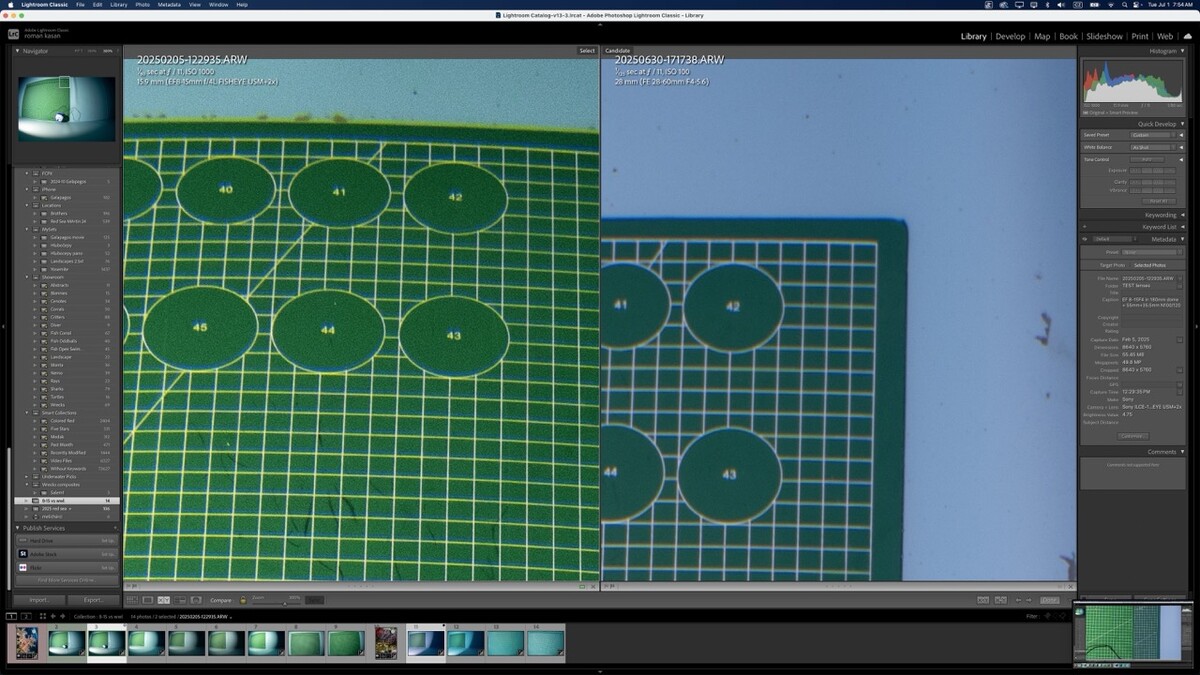
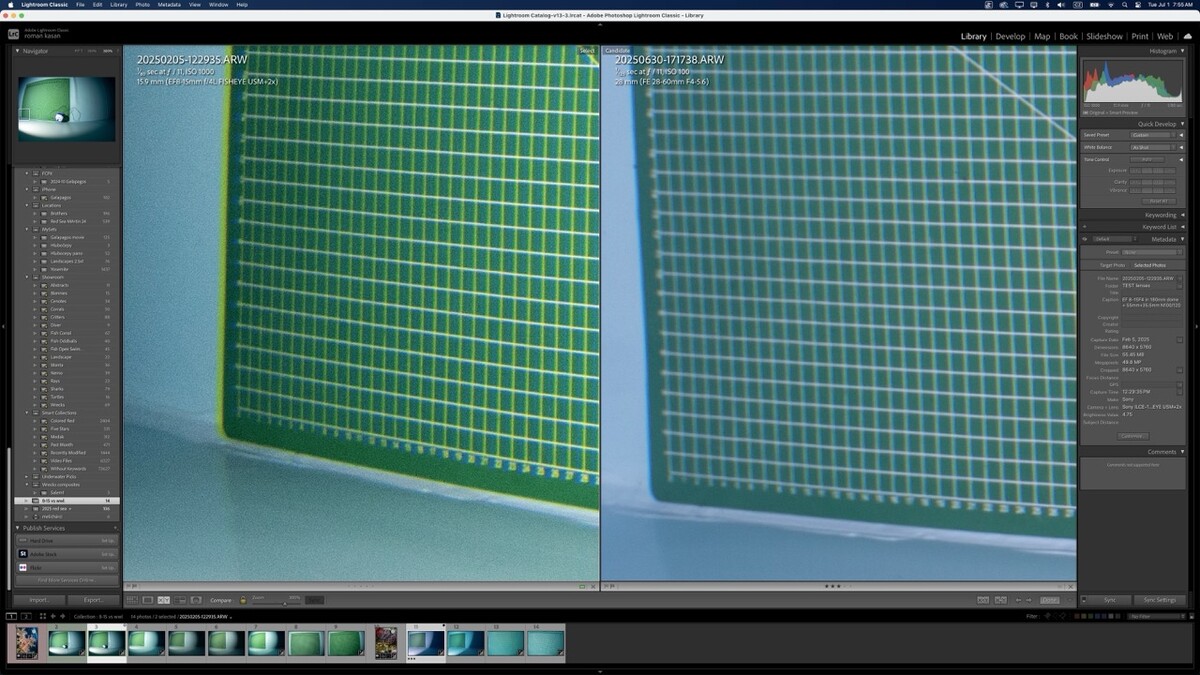
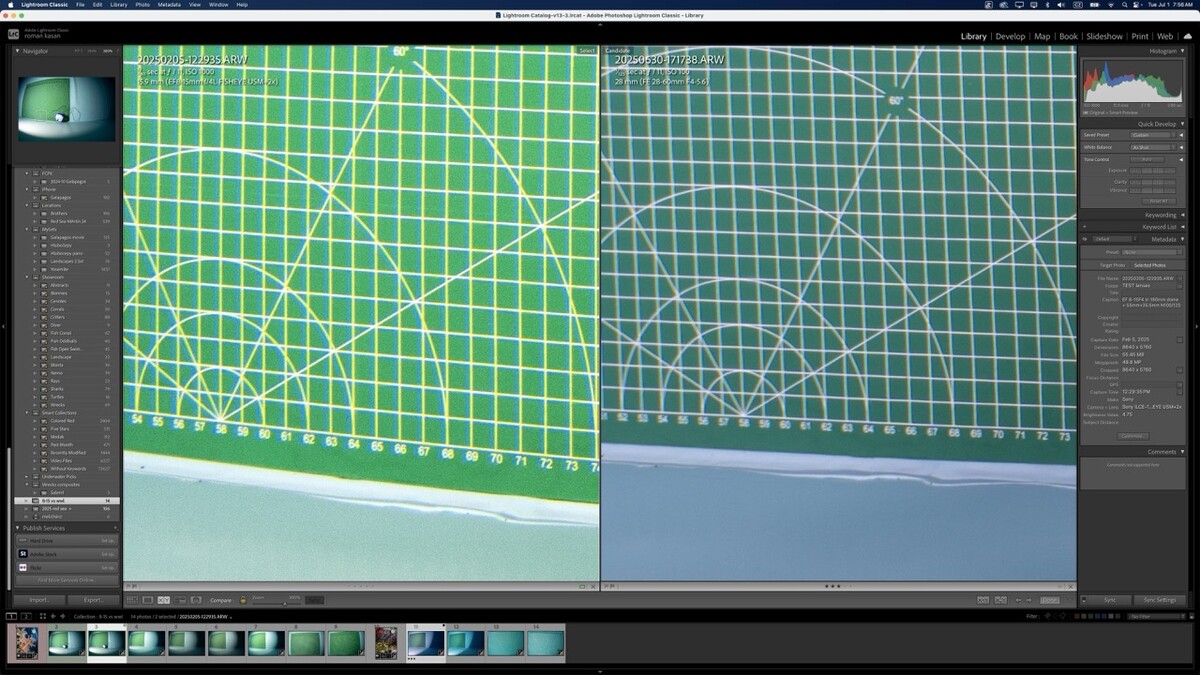
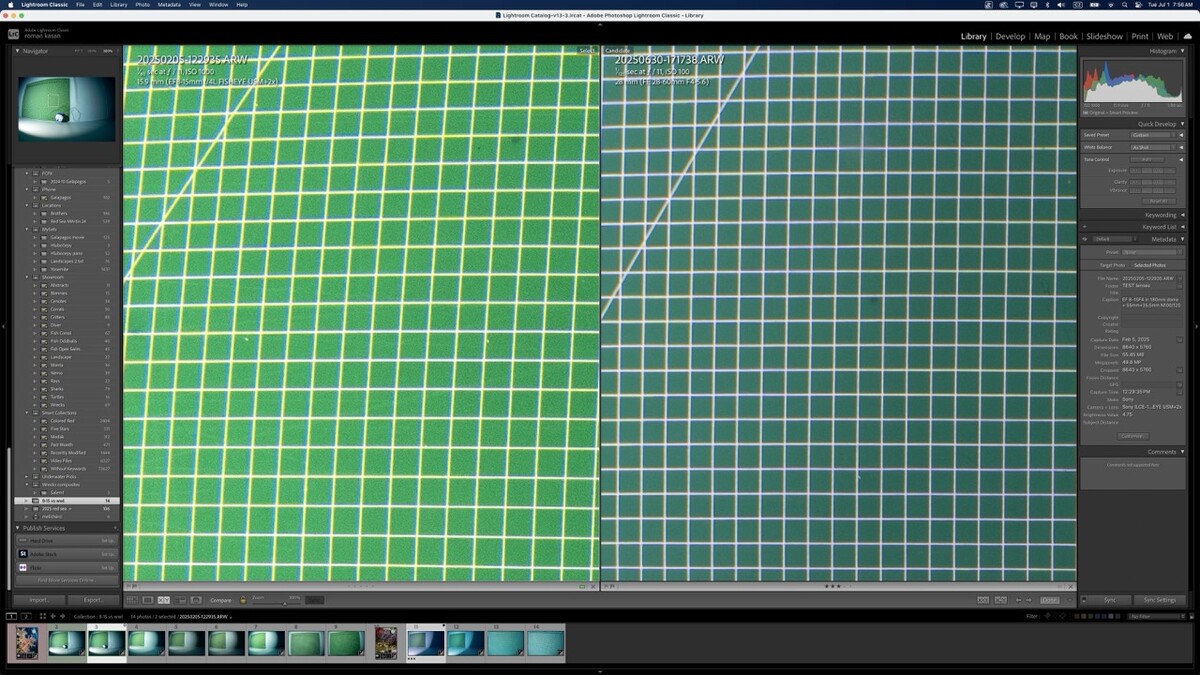
And finally 8-15 TC2x 55+35.5 in 140mm at 30mm vs WACP-C at 60mm
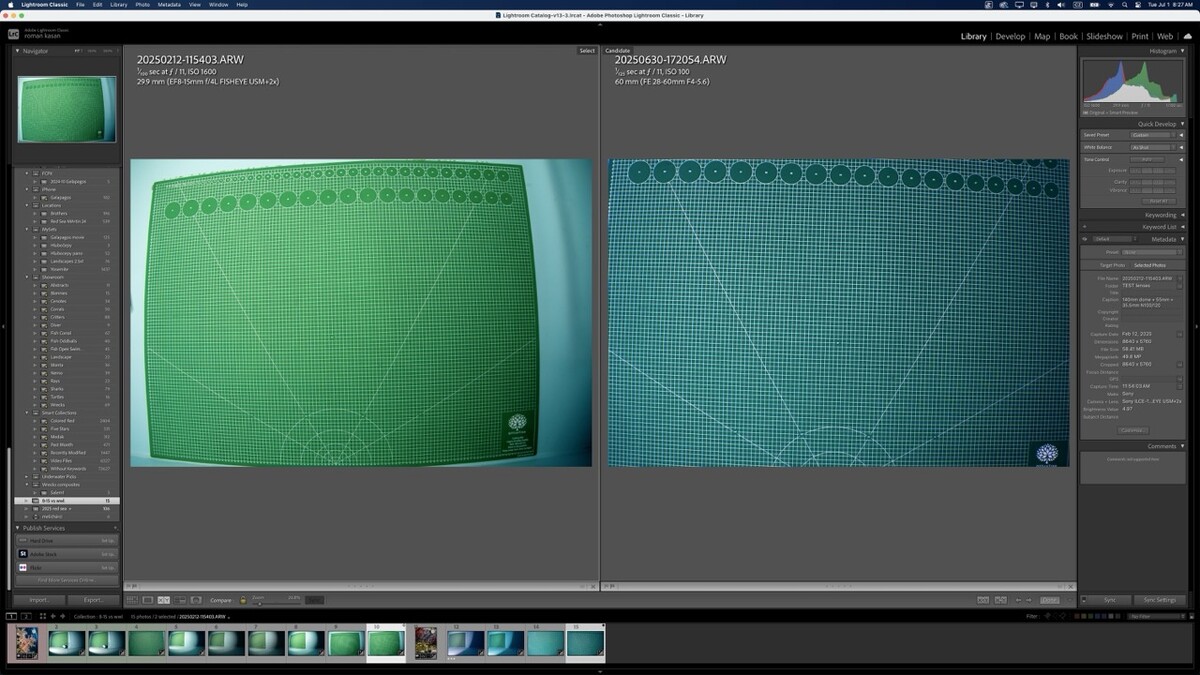
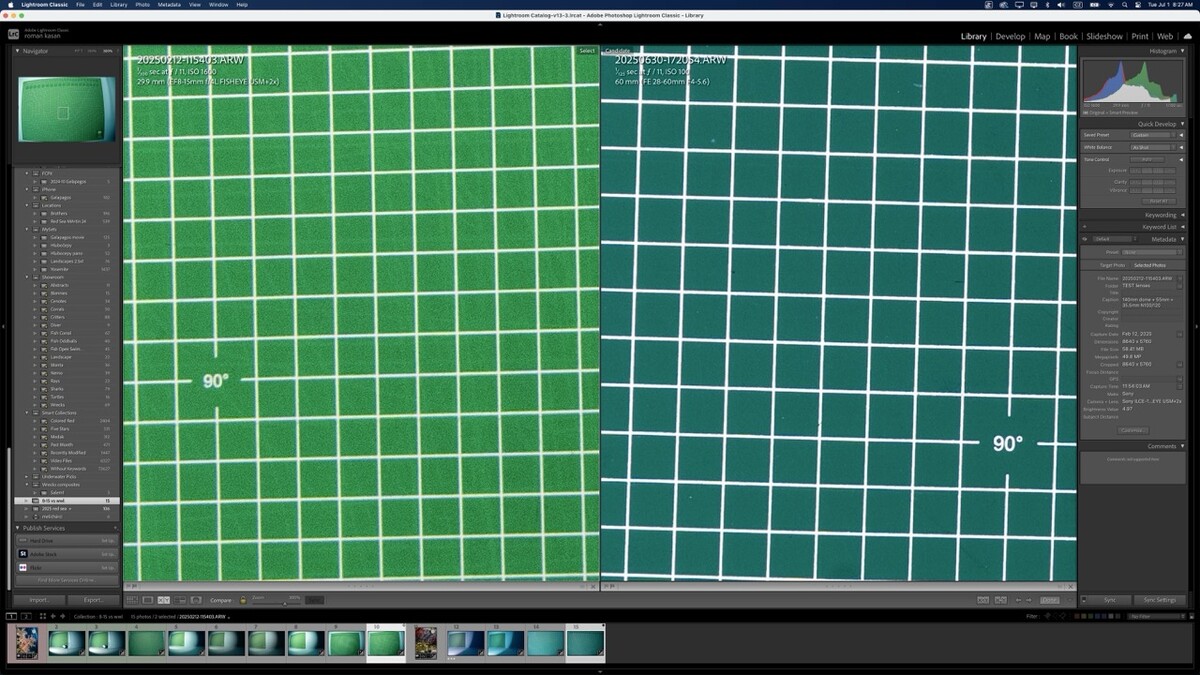
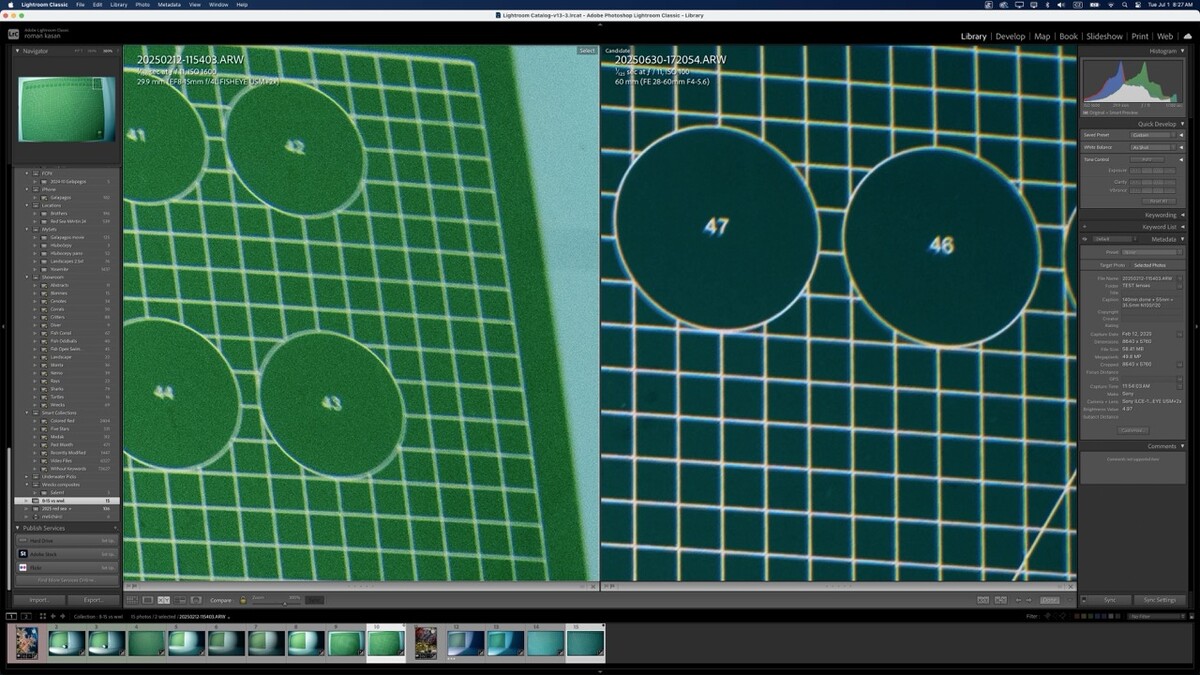
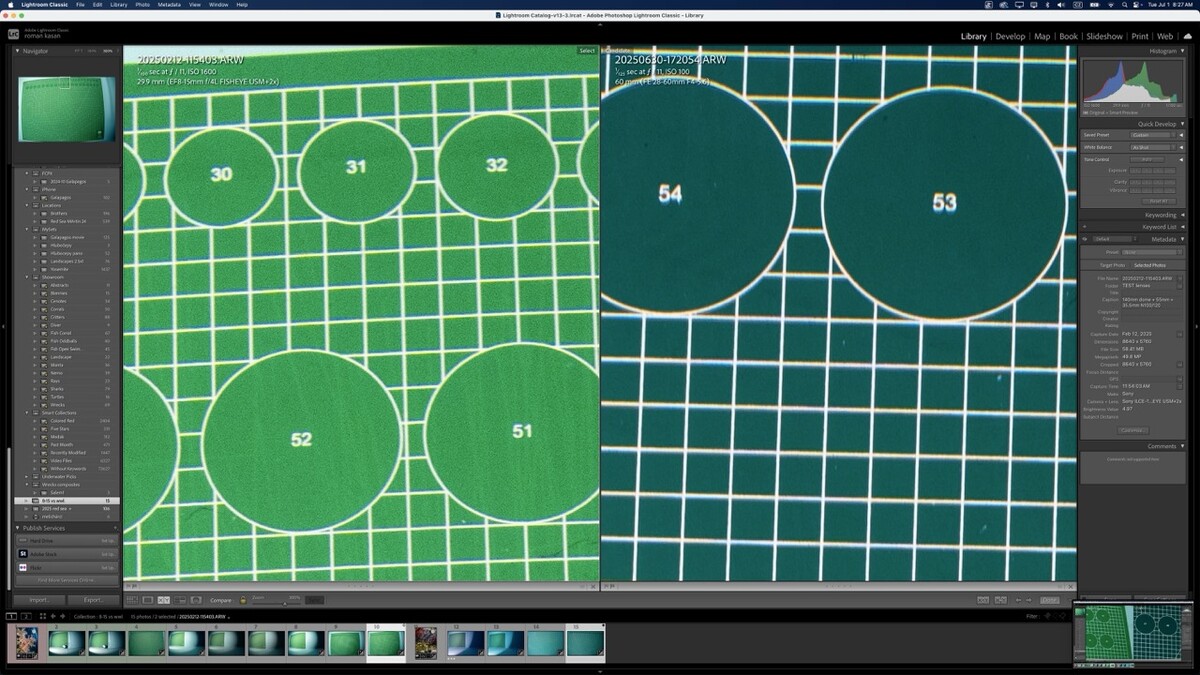
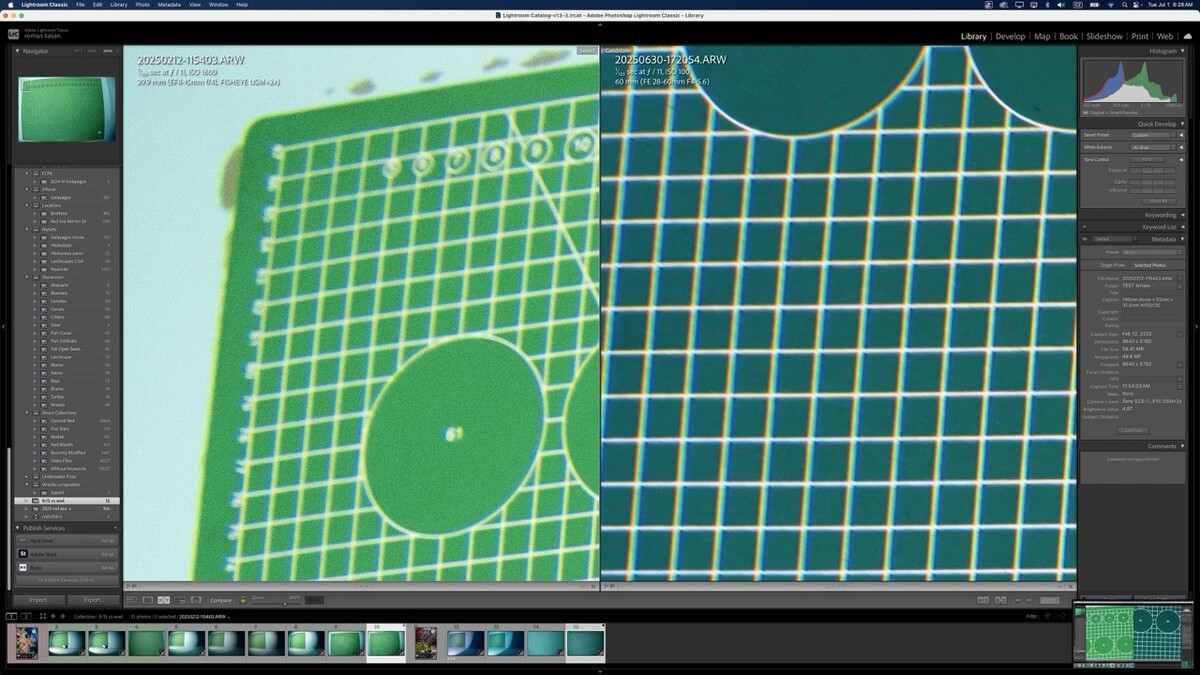
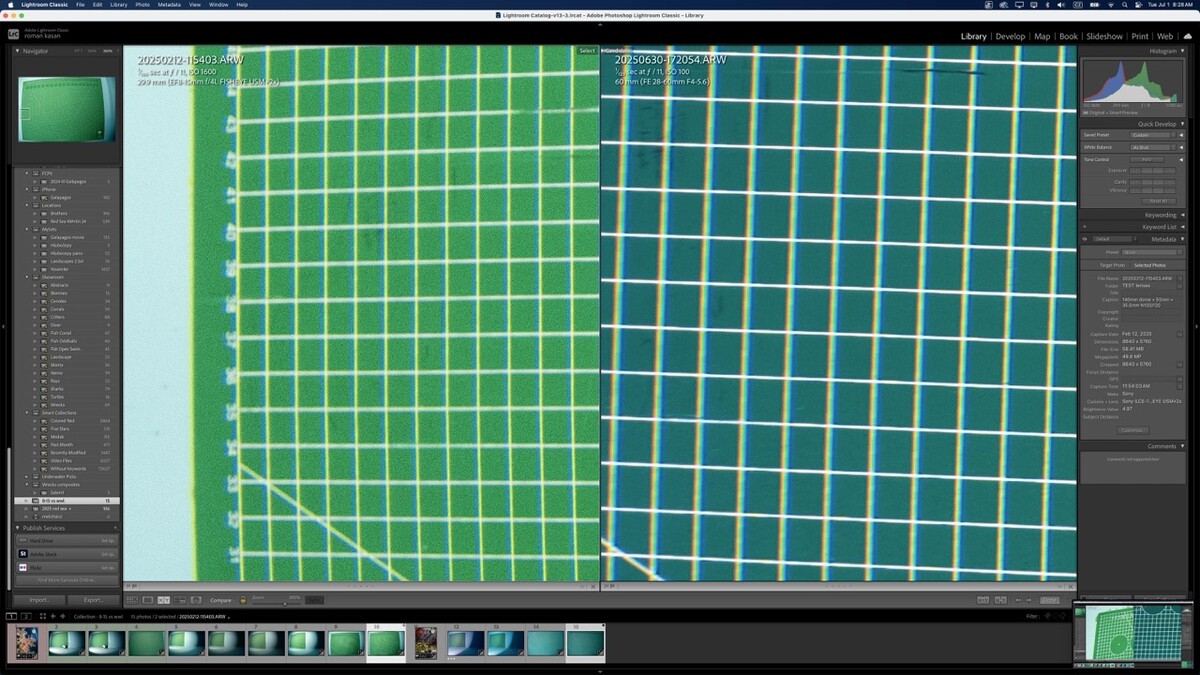
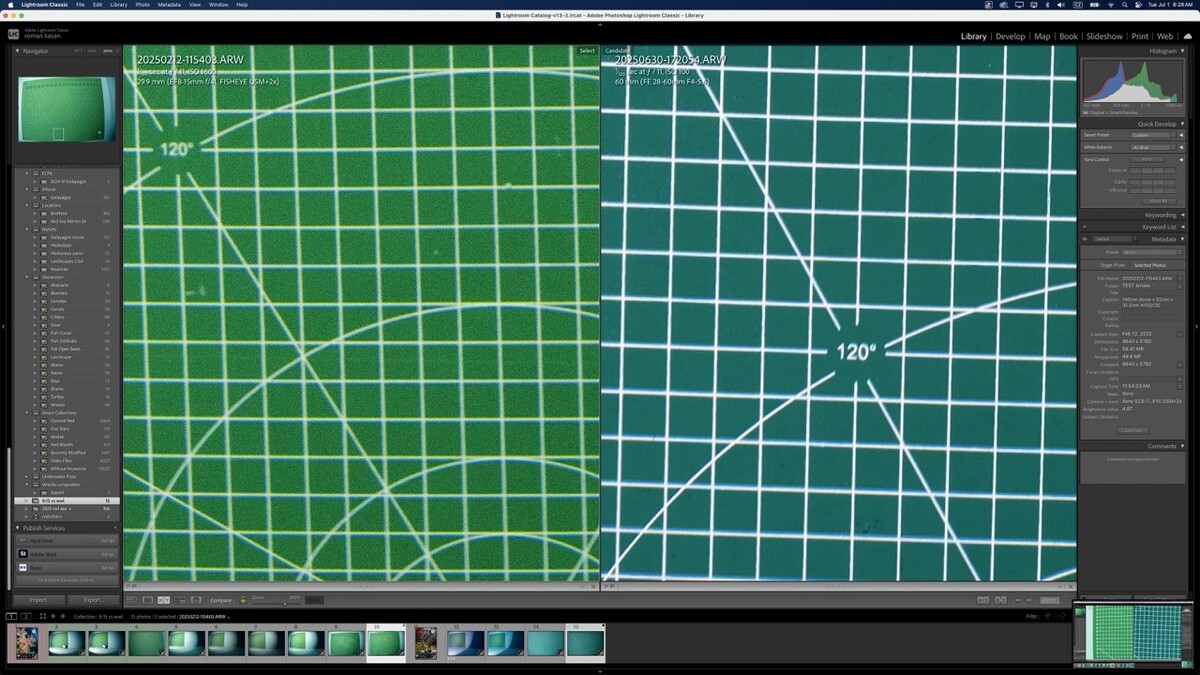
I am very happy with performance of WACP-C especially at 60mm as this is what I would be using for smaller subjects and crop heavily on 50Mpix image.
I will leave conclusions to yourselves :-). For me I realized that 180 degrees view is not as important as the DOF and native AF lens performance which doesn't mean I am going to sell 8-15 combo - yet. Cheers :-)
-
No I wasn't using Pure Video... honestly I forgot about that mode the entire trip, I got it like two days before. I am leaving for Indonesia next week so I will try it there. It didn't look though as there would be dark, this video was like at 18m at Yolanda reef in Red Sea during the clear day. There were other dives ideal for that I guess like Thistlegorm but again ... We will see next week ...
-
4 hours ago, bghazzal said: as a sidenote this YouTube Short format you posted in is unreadable on my laptop (Firefox) - I get this massive long display which takes ages to load and can't display properly even zooming out.
This is what it looks like zoomed out fully: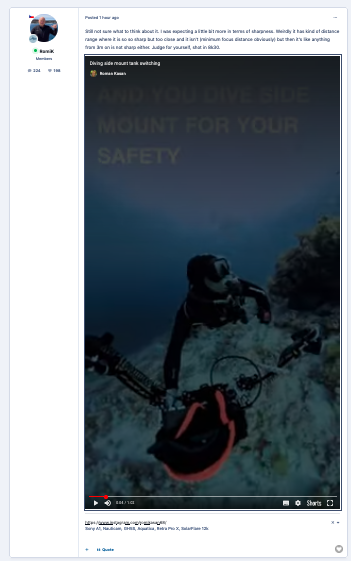
Wonder if other non-phonies are in the same boat?
Can't therefore comment on the vid/camera results, though I would have liked to see what it looked like!
cheersMaybe switching over to YouTube would help? These built in players have their own issues, YT should play fine. Just click.
-
Still not sure what to think about it. I was expecting a little bit more in terms of sharpness. Weirdly it has kind of distance range where it is so so sharp but too close and it isn't (minimum focus distance obviously) but then it's like anything from 3m on is not sharp either. Judge for yourself, shot in 8k30.
-
4 hours ago, Phil Rudin said: The 10mm needs a fisheye type port so 140 or 230 not 170/180. I am traveling so you can fine two or three photos with each port on my Instagram page, view the text for each photo to fine the 10mm shots.
Philrudinphotography
Thanks, I've tried but IG no good search and quality 🤯... It may be a good subject for next UWPmag perhaps... I bet most photographers hate to travel with 230 but if 140 would be good comparable for these ultra wide lenses you may get some more sales :-) Myself I will do some pool pics of Sony 14/1.8 in 140 but I don't have 230 to compare it with... Anyway safe travels and if the time would allow it would be great to post some higher res comps here.
-
On 6/18/2025 at 7:30 PM, MrPhilipps said: Nauticam just announced the housing…
But do you see it as a real alternative to the last compact camera models? The biggest problem for me would be 16-50mm lens. Might be nice for wide angle videos but 50mm is very limiting for macro, isn’t it?
Would be interested what you think 👍
I think with flat port and diopter it would be great for macro.
I am very excited about this Nauticam housing with this camera - combining (removable) dome port with the 16-50 (supposedly) almost constant length barrel it should provide image quality comparable to (in real world) any full frame camera with 25Mpix sensors. Plus it has good ergonomics plus the trigger for flash... It checks all buttons for ultimate pocket UW imaging device.
-
This may be a good option for anything wrecks and caves. I hate 230mm idea for its travel limitations but now when I have 140mm available I wonder what would be the real difference in frames quality @Phil Rudin 140 vs 230 - any comps of that 10mm by any chance?
-
180mm glass will be fine for central part of an image. out of center parts will suffer from CA and loss of sharpness because the light will come through more extreme angle through the glass. And that glass has some thickness... just think about it. That'a why 140mm dome with more curvy glass will introduce less of these. Obviously more you zoom in with TC less of these artifacts will be an issue because you will be using only central part of the dome and the light will come to lens under not so big angle... just physics. Look up my thread with lab examples.
-
3 hours ago, Architeuthis said: One of the view exceptions when a 45° viewfinder is suboptimal is when making photos vertically downwards (e.g. rotational panning).
Also with EMWL (I do not have one, but am thinking about it) it may be better to use the screen on the back, since my camera (A7R5) has the possibility to flip and mirror image the screen image (unfortunately not the image in the EVF). This allows to use EMWL without the expensive, clumsy and heavy "relay" unit (or the additional "inverting" 45° viewfinder).
Damn! Sony engineers didn't think A1 would need this function 😣 I guess since it doesnt have flippable monitor 🤦. And even though Shinobi does have flip option there is no way to change it during the dive so I'd be stuck with EMWL for entire dive.
Back to topic - a slight disadvantage to using the VF is the loss of surroundings awareness. Like when shooting seals I was scanning with periphery vision what coming next and from where. Also less ideal for video.
-
In short - sometimes...
For comparison first I am bringing 2 images shot on the same location (Carnatic shipwreck at Abu Nuhas, Red Sea) 1 year apart shot using WWL-1B and adapted canon's 8-15 (no TC). I would say it even may be the same corral just shot from different side.
First WWL-1B from 2024
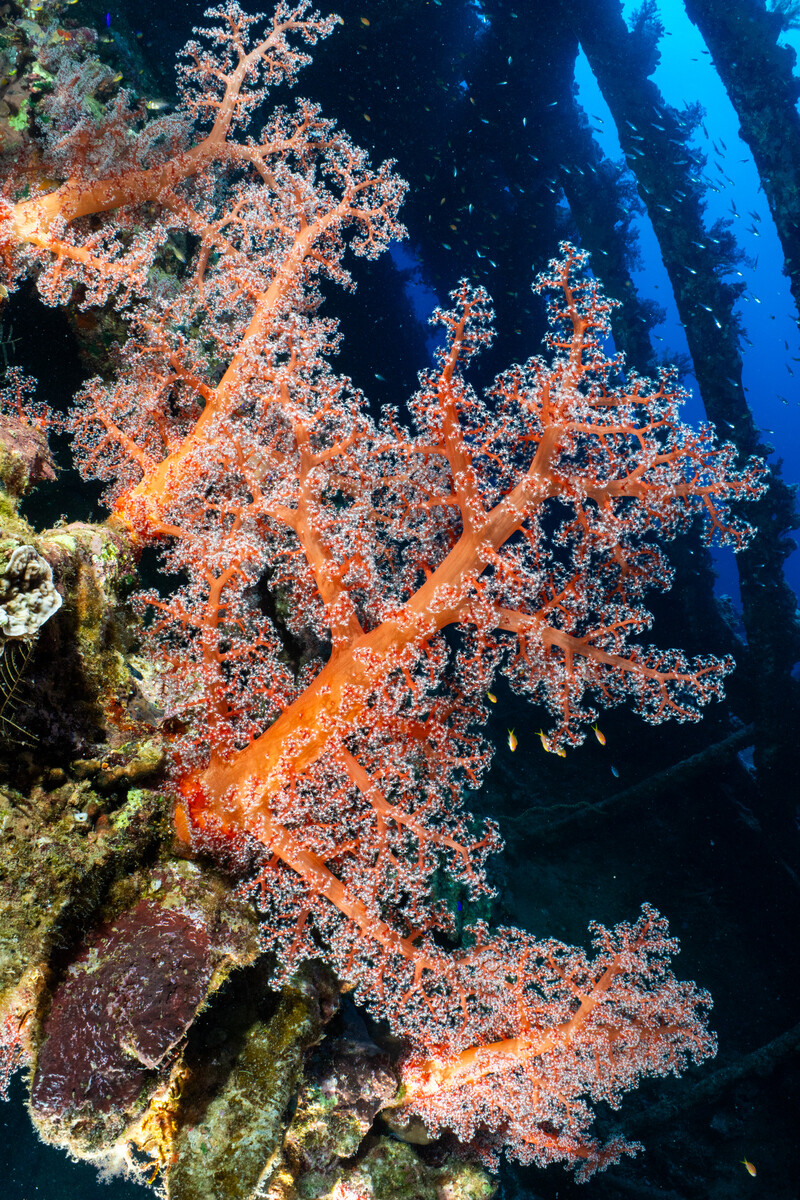
300% central part
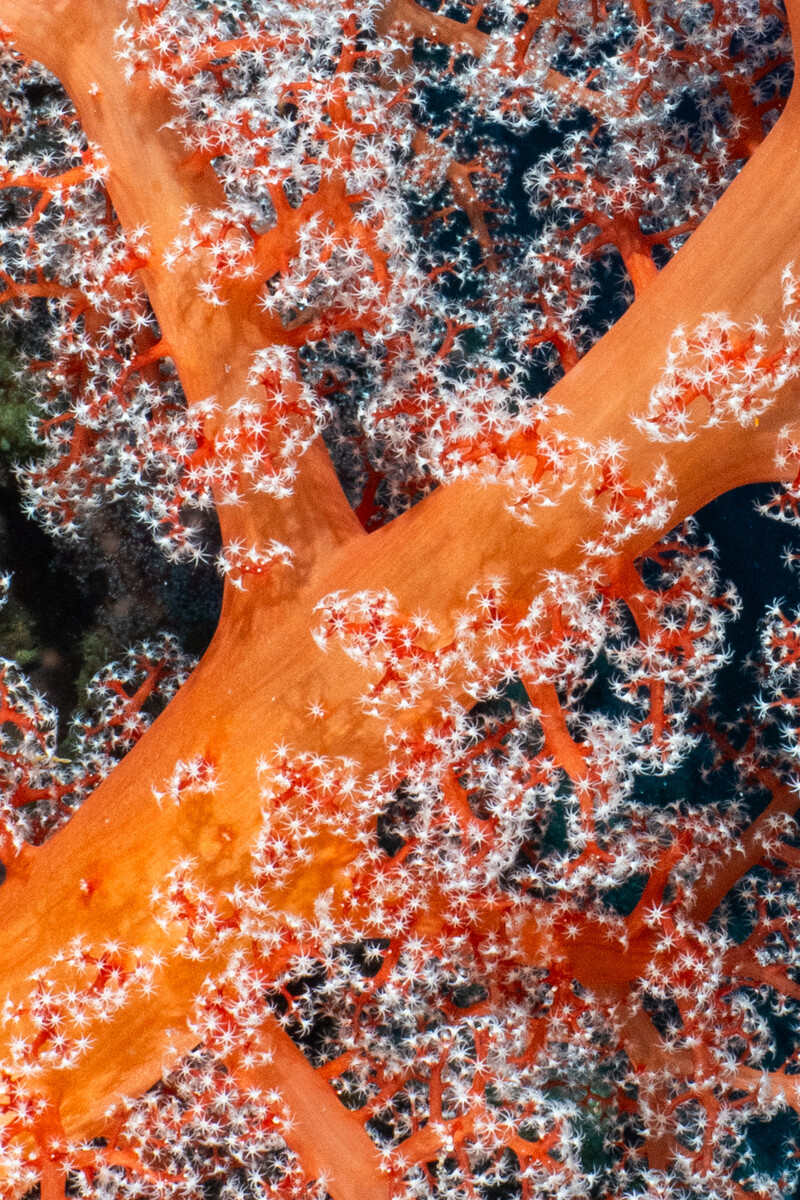
and 300% kind of out of center to show depth of field
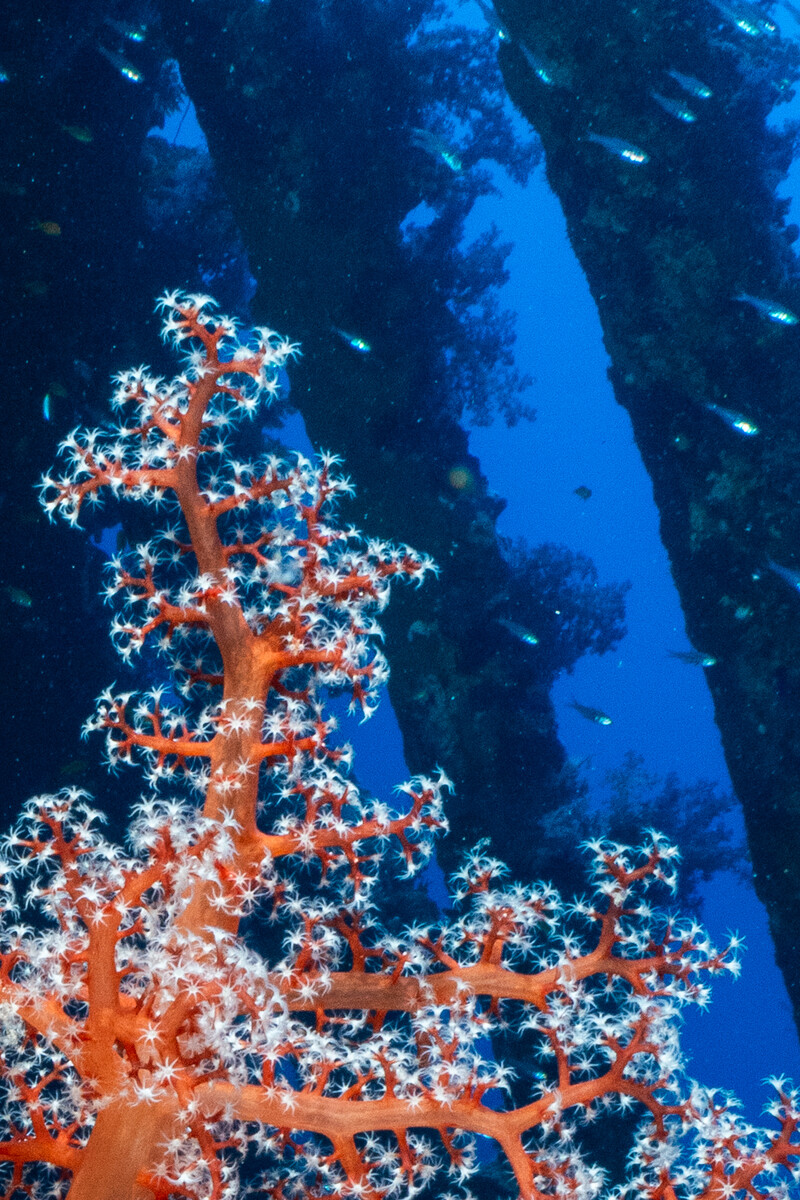
And kind of extreme corner lower right
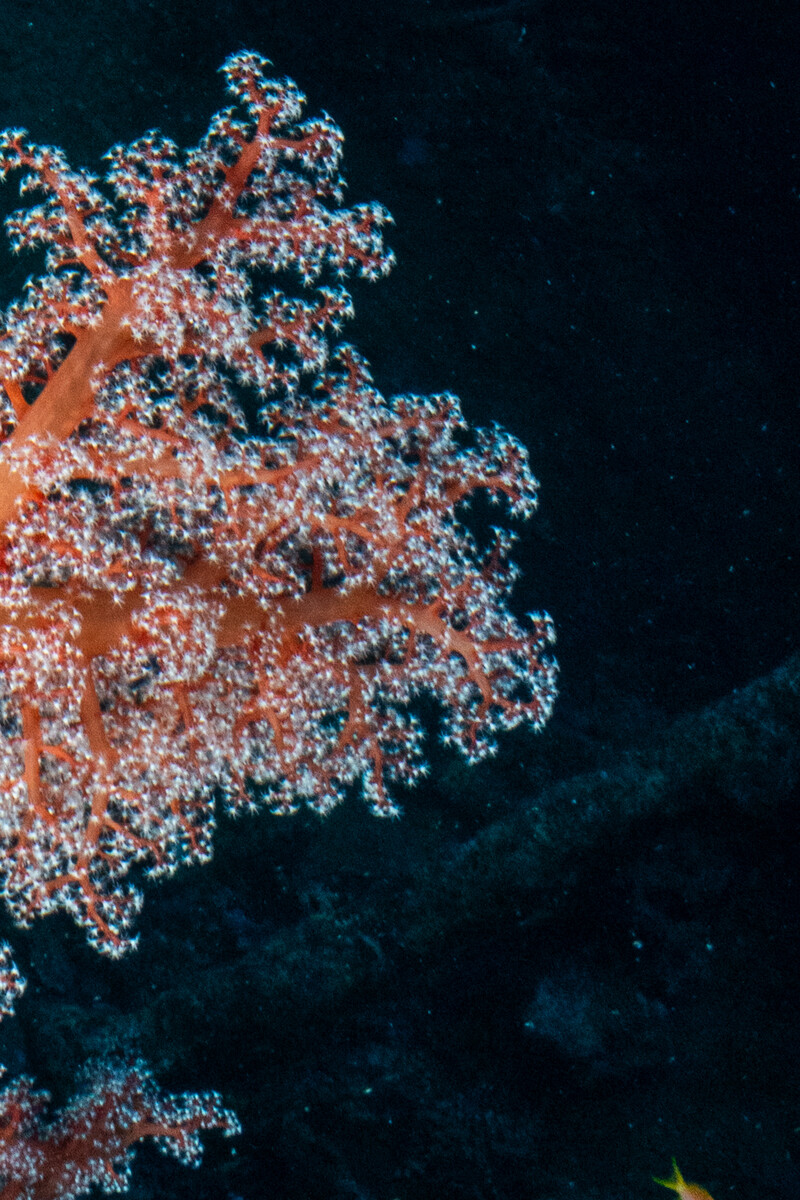
Now the same for 8-15 at 15mm F10
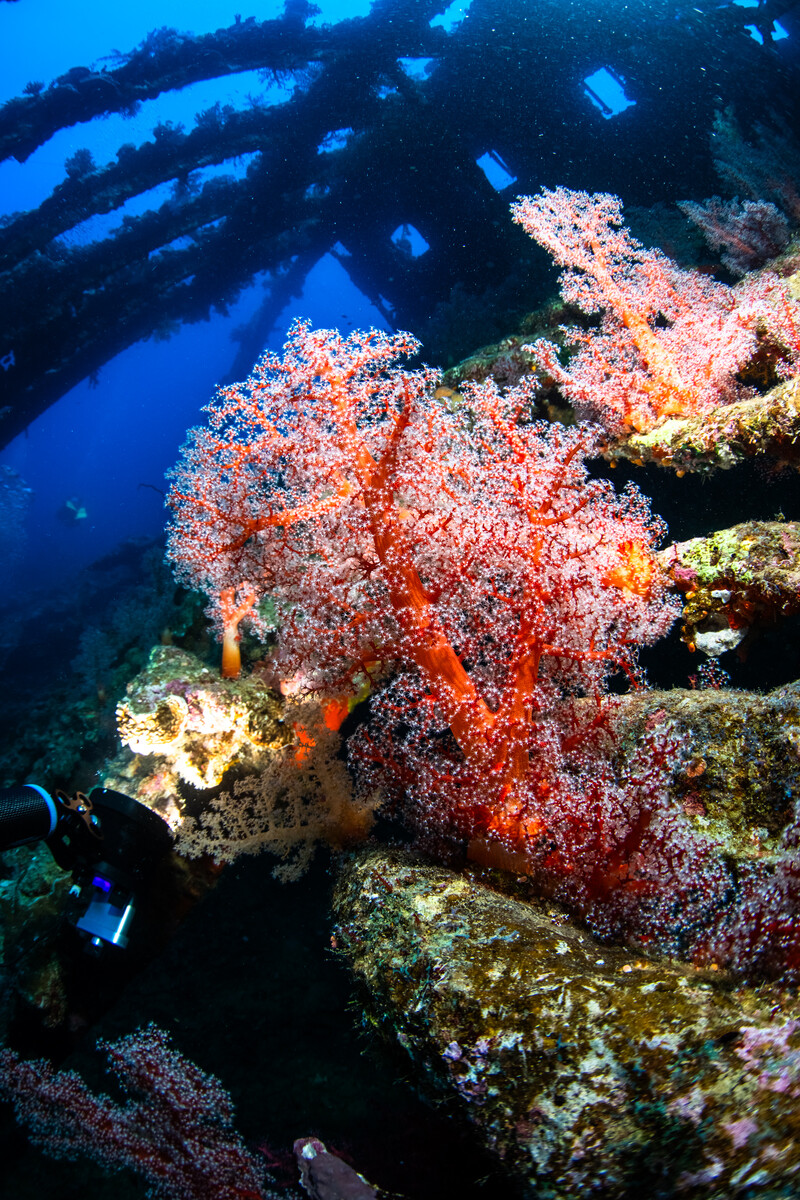
center
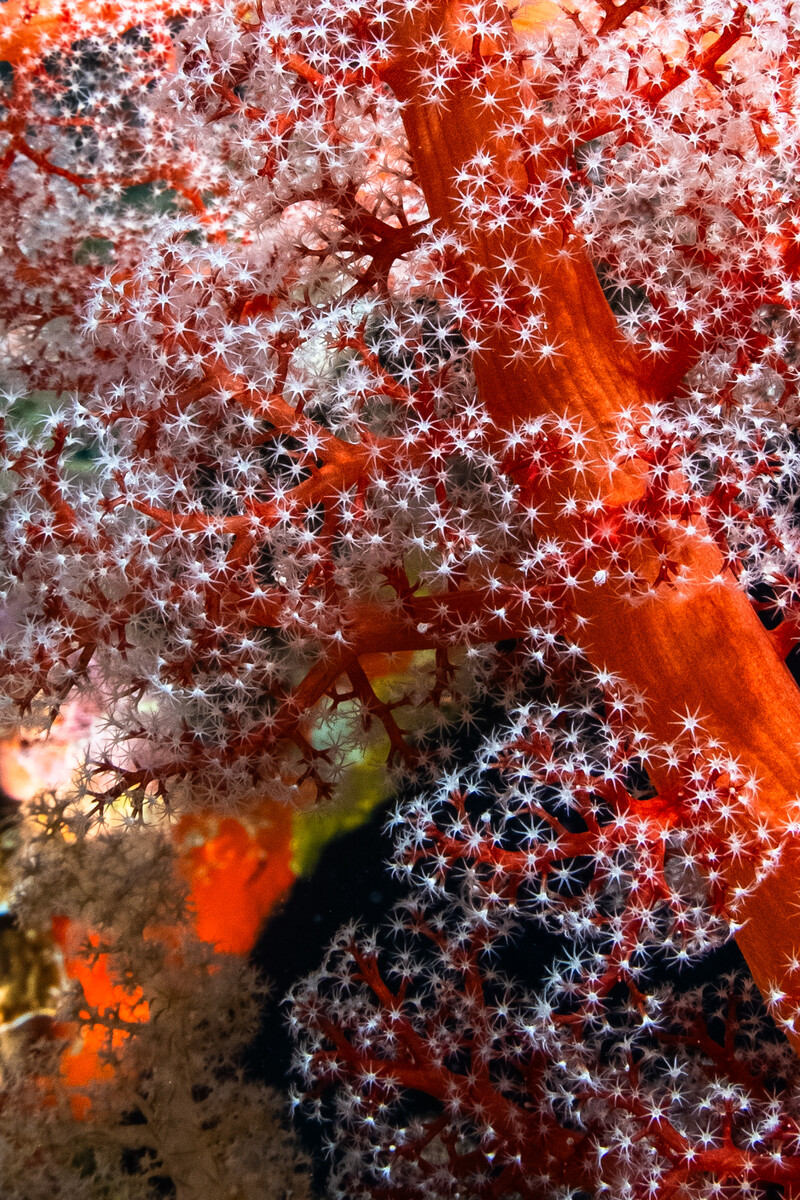
off center with background
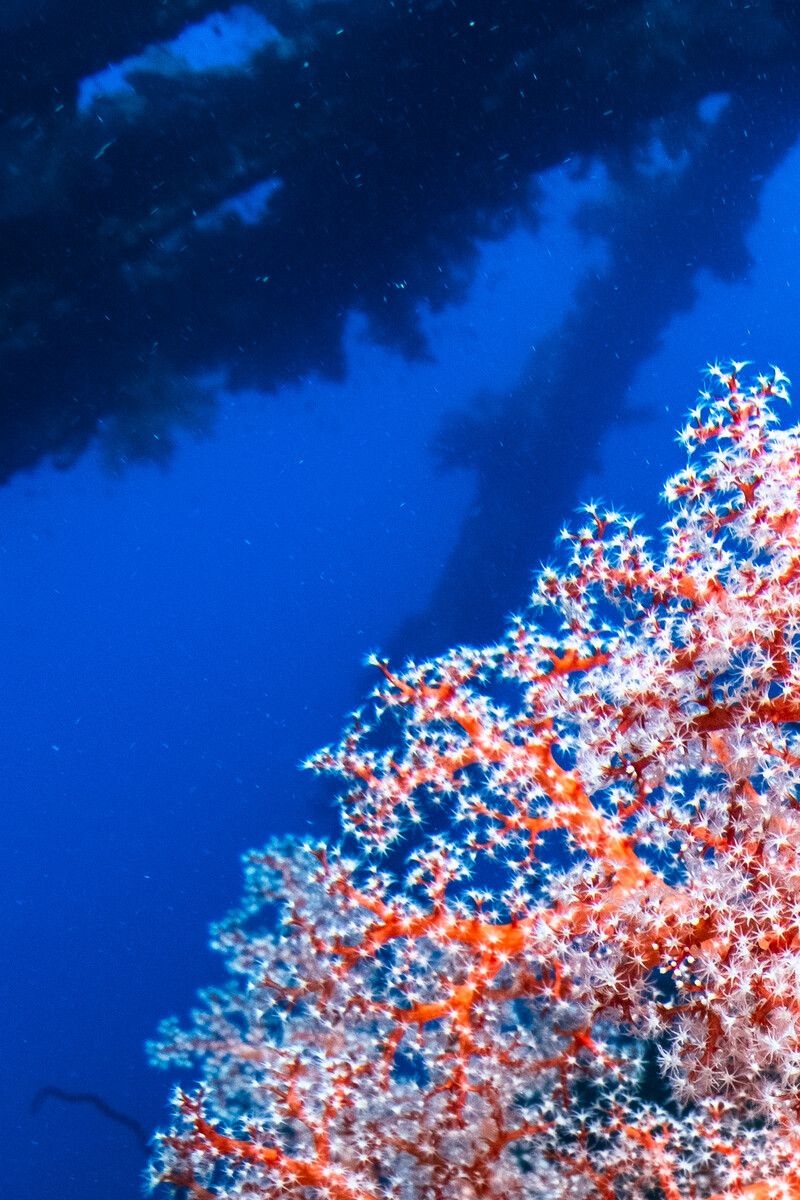
and the corner lower right
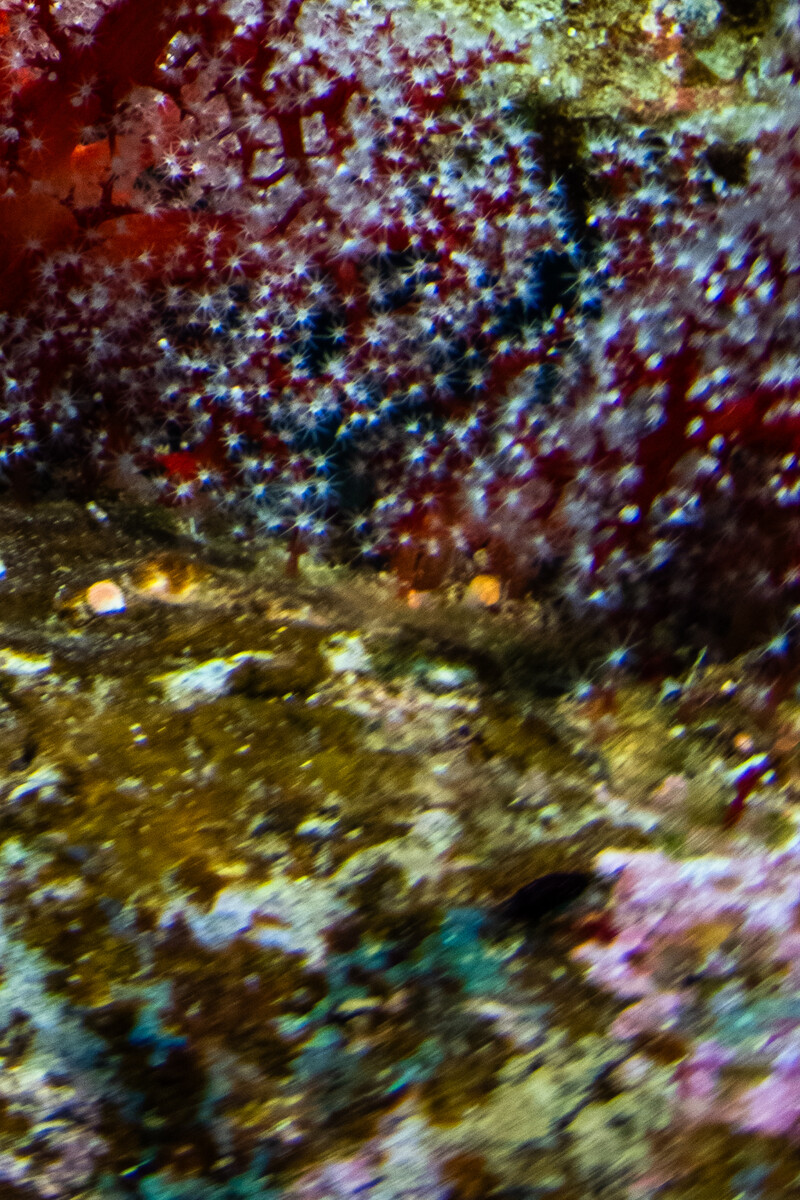
You can clearly see that 8-15 significantly outperforms WWL/28-60 on subjects sharpness, micro contrast and overall rendering. Where WWL excels is a uniform unsharpness 🙈 across the frame and much greater perceptual depth of field for entire image viewed on a small device.
And it's kind of logical. Nauticams wet optics (WWL, WACPs, FCP) final results on Sony (do not know canons and nikons lenses) are held back by poorly performing 28-60 which - compared to canons 8-15 - is soft and especially on tight end with relatively poor micro contrast and overall rendering. On the other end if one doesn't plan to crop heavily or print large HD prints then it doesn't matter that much and this expensive wet optics will produce nice postcard size images🙈.
Fisheye on the other hand will produce much greater field of view which also means that one has to get much closer to the subject for meaningful impact which means that one needs to select the scene very carefully otherwise only central piece of image is going to be in focus and the rest will be a mess. Especially for concave scenes (like small caves where subject is in the middle in the back - see pictures below) the use of this fisheye lens would be less then ideal. Basically for CFWA shots like clownfish anemone sunburst it's like 1:10 you could get into a good position while with wet optics much less.
These results are not surprising as for DOF and are in line with dome theory and wet optics theory. Simply said with fisheye you need to be so close to the subject that you effectively focus at minimum focus distance for lens while hyperfocal would be much further away. With all DOF implications. For subject-less scenes 3m away this would be different but for smaller subjects you need to get real close.
I have had TC2x only on first dive and at first glance I didn't like the results so I skipped using it - perhaps prematurely judging from anemone detail taken at 30mm... oh well. And also this is an example of that wrong scene for fisheye lens.
So 8-15 TC2x at 15mm
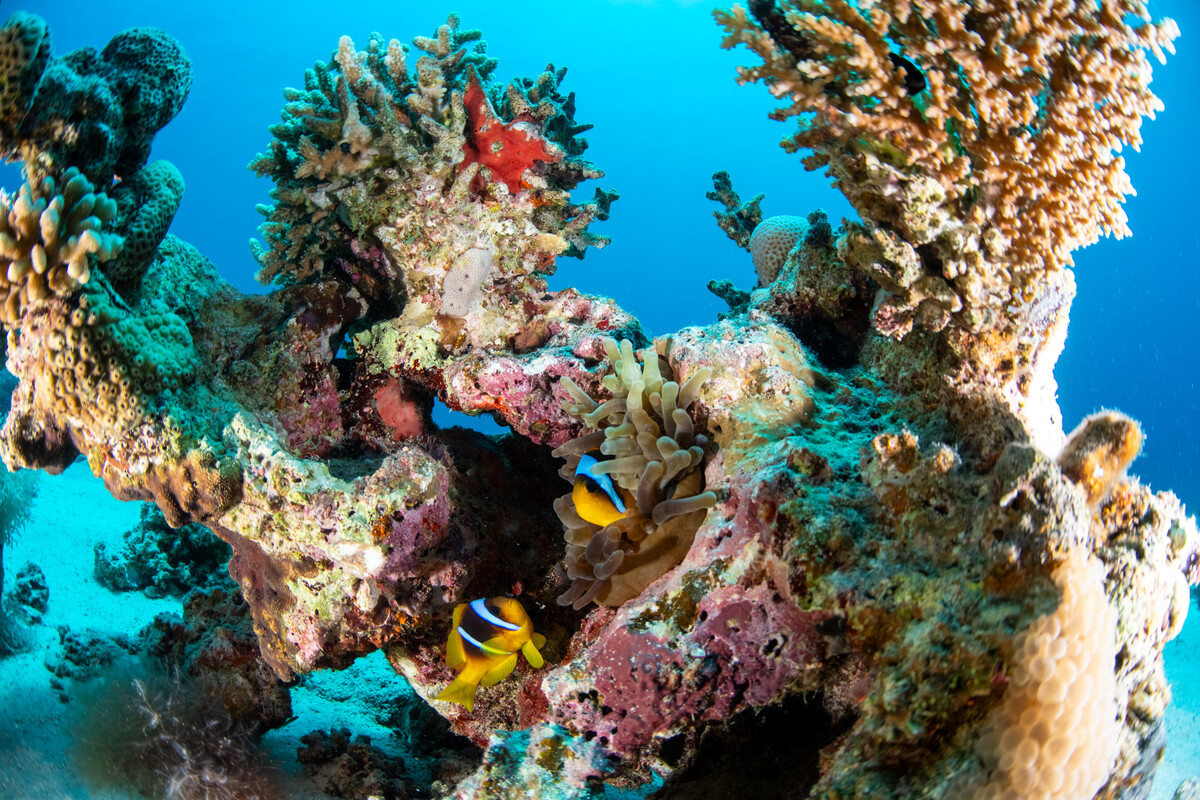
the same scene at 30mm
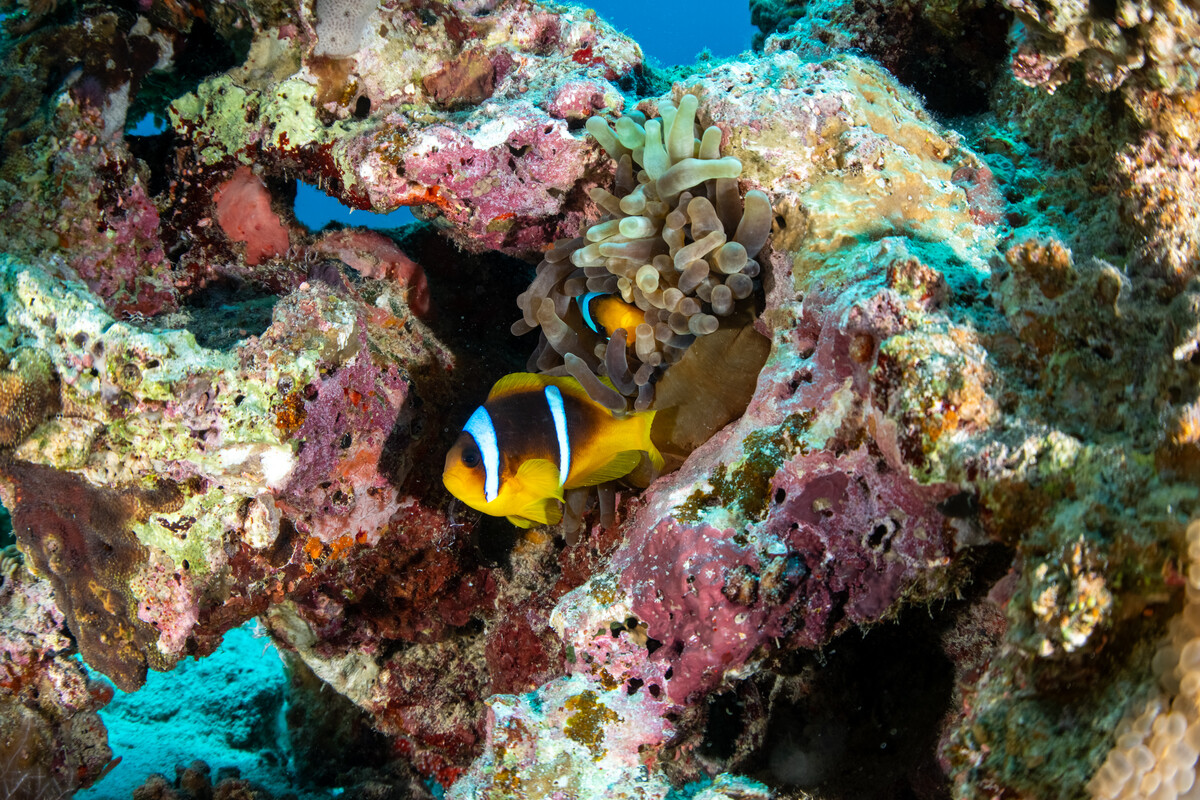
and 300% crop
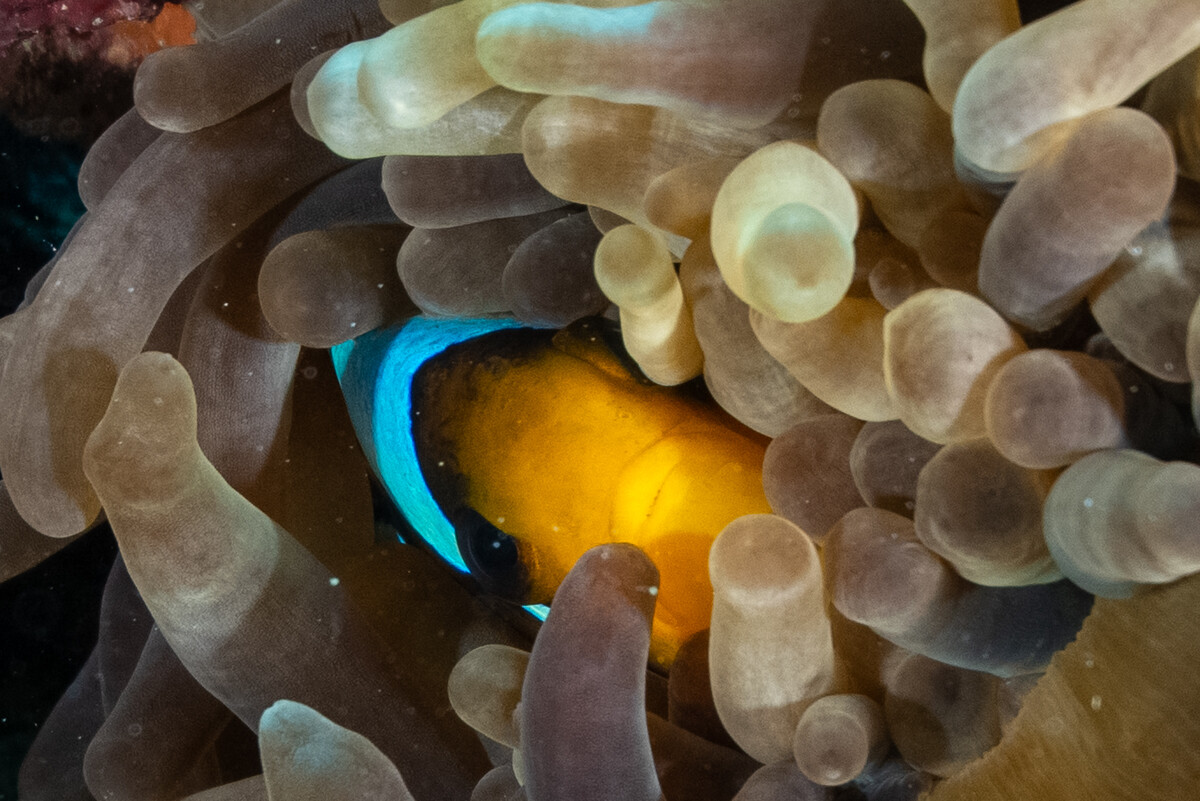
So this is my experience with adapted 8-15 which except for autofocus misses fulfilled my overall expectations even though it brought different set of challenges. And lastly following image shows example of a neutrally buoyant configuration - 140mm glass dome + 35 + 20 + 8-15 + Metabones + Sony TC2x + A1 + Shinobi (NPF970 battery) + Retra Pro X with superchargers
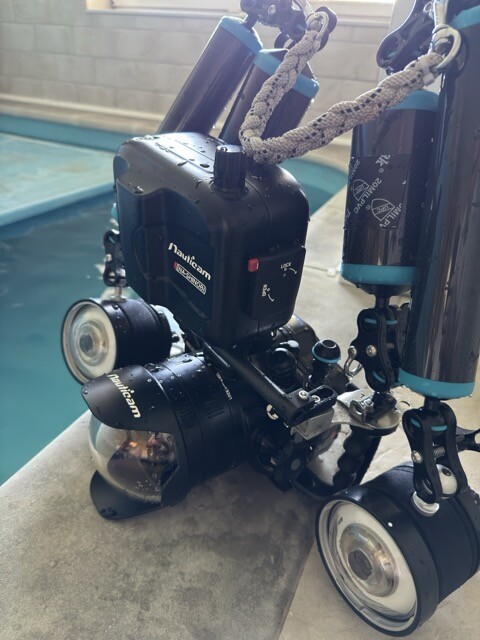
-
-
-
1 hour ago, RobinD said: I agree, they seem to be with different focus point - lower right quarters show that. Or they weren't and that would be a bit of a problem. Tough to say.
-
3 hours ago, RobinD said: on my first dive with the mfo I took a picture with and without the mfo, just to try. Free floating in drysuit in a silty lake in the Netherlands, so a little shift in position. This shot is from a 105 macro (AF-S 105mm F/2.8G IF-ED VR) in the bottom corner on fullframe DSLR. No sharpening, removal of CA etc. F16 1/60 iso 100. In the centre the difference is still there, but less noticable. Left mfo, right no mfo
I'd like to see center frames. It's where usually my subject is. From what I saw so far this WCoptics degrades an image quality a little compared to bare lens. Microcontrast and shapness... the pop.
-
On 5/16/2025 at 10:01 AM, eocean-eu said: I am using 5 and 7inches Weefine monitors on the GH5 and Z8 and while they works flawlessly on the GH5, the Z8 has long blackout with the 5inches in video mode (lenghty EDID handshake apparently)
IDK if it helps but my experience with blackout on Sony A1 and Shinobi - it was there had resolution set to Auto or 4k30 in camera HDMI settings. When I set the HDMI settings to 1080p60 there was no blackout when switching modes anymore. Apparently camera is negotiating with monitor for the best resolution for given mode. When it doesn't negotiate there is no blackout and 1080p60 works well for both photo and video - no need to have 4k when monitor is 1080p anyway... BUT IDK weefine internals so...
-
On 5/11/2025 at 11:48 AM, Davide DB said: So, IMHO, HDR is a non-issue.
Here are a couple of links on that:
https://vmi.tv/blog/learn-help/hdr_reality_and_monitoring-a_dops_perspective/
If we accept the notion of being able to see what you get affects the artistic expression then it absolutely matters being able to see what you record in HDR if HDR is intended delivery. Only now I am beginning to understand that I am one of only a few which try to shoot and deliver in rec.2020 and I can tell you in these selected few light conditions where you don't see a thing in rec709 but do see beautiful scenes in 2020 renderings it absolutely matters to see what you get. Scenes which you would pass on in rec709 come to life with 2020 but if you can't see that it will limit your imagination.
-
-
To me it is a wasted opportunity and it is going to be a sales flop. I can't imagine a videographer excited about placing negative 0.86kg (like 2lb) (!!!) on top of their rig and plus having no option for LUT or at least some kind of generic HDR preview like Atomos offers. To me this launch is some kind of a partnership with scuba lamp or weefine kind of companies which launched similar brick products and they just mill out their own housing and their own version of a power source.
If I'd be a Nauticam I'd try to work with likes of Atomos to somewhat adjust their touch base UI to more centralized for use with fewer touch based contact point (after all we rarely adjust our monitors on the fly under water), take that product (Ninja or Shinobi) and run with it. Heck they could charge extra for that software version which is like clear profit...
Is there an emoji for frustrated...
-
To chime in
no need to use Enelopes - Ikea's Ladda 2450mAh work perfectly, priced at less than $10/4pc and did you know they are made in Japan? (do your own research re: NiMH quality based on factory locations)
I always transport and store Retra without batteries to prevent contacts spring board fatigue (see point 3) and also to make the carry on lighter if needed. I learned to use fanny pack for all my batteries (24AA for strobes - always charge spare 8 on liveaboards and change one strobe between dives if needed, then camera, lights and monitor batteries) and if I sense problem I just put these extra 2kg on my waist :-)
I had my fair share of issues with contact boards as my strobes (Retra Pro X with superchargers) experienced loss of power. I just couldn't swith them on. First I thought these were fatigued terminals and when I tried to spring them back off course I broke them - NEVER do this (!!). So I bought like 4 extra contact boards from Retra. But the issue could have been - all this time - oxidized contact pins inside of the main body. Because when I couldn't start the strobe last time I had quite fresh contact board so I thought this could not have been the issue - I checked the pins inside and sure enough one of them look not ok so I scratched it with flat screwdriver and voila - the strobe was starting again
@Oskar - Retra UWT - because we all use these strobes in oxidation happy environment and these pins inside are so difficult to reach would it be a good idea to come up with some sort of tool better then the flat scredriwer as the pins are rounded... Although if future strobes will be Lion acc powered it may not be an issue anymore.
-
5 hours ago, brightnight said:
Very interesting. I'm suprised to hear the the 28-60 is sharper than the 28-70, that's news to me! Now I'll have to dig in and do some reading.
Not sure if the 28-60 only applies to Sony or if it also applies to a canon DSLR like the 5D mkIV I'm using. Nowhere in the Canon 120 Port Chart do they mention the 28-60 and had I purposely picked the 28-70mm for the sharpness and very little for the zoom range since I'm almost never shooting at 70mm.
Oh nooo - 🫣 I thought you are Sony when mentioned 28-70 with WACP… canon’s 28-70 didn’t come up in my recollection of wacp chart… so I take it back as I know nothing about Canon’s 28-70
-
I would add before you do anything switch 28-70 for 28-60 and see results. If sharpness is the motivation 28-60 is sooo much sharper than 28-70. For wide-angle motivation obviously the choice is clear. I would use Sony TC2x as usability of zoom range in rivers and streams will far outweigh any minuscule feelings about quality. Having said that for ultimate quality I'd skip TC altogether as I am sensing in river and streams you want to bump into your subject anyway so I would leave 8-15 at 15 and just shoot those yellow perches out of the water 🙂. No TC 8-15 performance is stellar both in sharpness and micro contrast all the way from F4.
Another benefit from using 140mm I would appreciate in river and streams is the small size.
The drawback from 8-15 with 140 and especially TCs is that the rig will be a brick. A1 housing with 8-15 + metabones + TC2x and 140 is negative 1kg (!!) May not matter in rivers and streams though.




What does EUR4000 get you (WACP-C vs 8-15 TC2x)
in Photography Gear and Technique
·
Edited by RomiK
My initial thoughts would be that because you get to the subject closer with FCP your lens behind it focuses on shorter distance which means that hyperfocal DOF will be shifted towards the camera. Like if a lens DOF is 2m-inf at F11 (which means you are like 60cm from subject with wacpc) then with FCP you need to get closer with that wonderful 180 to have the same size of subject in the frame which means now you are focusing at 1.2m being only 40cm from subject and then you are getting 1.2m-3m DOF at F11. I am taking focus point as a mean point in DOF expression, what is before that doesn’t interests me for this explanation if it makes sense. This would be my take on why DOF is different with FCP from WACP with the same lens. And that’s when we think the magnification is the same 0.36. If it would be different the principle is the same with just another variable. Or I am completely wrong 🤣.